The Israel Guide
Explore israel with heiko sieger, your private tour guide, akko / acre.

The port city of Akko (also known as Acre) is one of the oldest continuously inhabited sites in the world. Owing to its natural harbor on the Mediterranean sea, it served as a strategic link to the Levant. The ancient Akko, first mentioned in the Egyptian Execration Texts almost 4,000 years ago, lies to the east of the old city on Tel Akko. Excavations have revealed a settlement as early as 3,000 BCE.
During the Hellenistic period the ancient city of Akko was abandoned and a new, fortified city was built on the site of present-day Akko. This city was renamed Ptolemais, after Ptolemy the Second, ruler of Egypt. Later the Romans enlarged the city as well as the harbor south to the city and constructed a breakwater, making it one of the main ports on the eastern Mediterranean coast.

In 638 CE Akko came under the rule of the Rashidun caliphate who called the city Akka . Under Islam it once again flourished, owing to its importance as a naval base and main port of Palestine. The crusaders, who had first bypassed the city on their way to conquer Jerusalem, finally took Akko in 1104, after a 4 year siege and the help of the Genoese fleet. Acre, as we call it now, became the main port of and a source of wealth for the crusader kingdom. Precious goods such as spices and incense were shipped to Europe, and many pilgrims got a first look of the Holy Land when they arrived by ship in Acre.
After Saladin defeated the crusaders in the decisive battle at the Horns of Hittin (also spelled Hattin ) in 1187 CE, he took Acre without fight. Richard the Lionheart reconquered Acre in 1191 and Acre became the de facto capital of the Kingdom of Jerusalem. It would soon be known as St. John d’Acre, after the Knights Hospitaller of St. John order who had their headquarters there. Acre became a major commercial hub on the eastern Mediterranean, with a population of about 40,000. The kings palace (called castrum ) was located in the northern part of Acre, surrounded by massive fortifications. Next to the harbor, the Italian maritime cities of Genoa, Pisa, and Venice established merchant quarters known as communes. Each commune had its marketplace with shops and warehouses, and homes for the merchant families. But the city also suffered from bitter infighting among the crusader factions, sometimes leading to civil war.

Acre was the final stronghold of the crusaders against the Muslim forces, when the city capitulated to the Mamluks in 1291. To prevent any future use by crusaders, the Mamluks destroyed the entire city save some Muslim shrines. In the years to come a tiny fishing village was established. Later during the Ottoman rule, Henry Maundrell, a priest and pilgrim from Oxford who traveled to Jerusalem in 1697, writes in his diary (published as Journey from Aleppo to Jerusalem at Easter A.D. 1697):
But notwithstanding all these advantages, it has not been able to recover it self, since its last fatal overthrow. For besides a large kane [khan or caravanserai] in which the French factors [merchants] have taken up their quarters, and a mosque, and a few poor cottages, you see nothing here but a vast and spacious ruin.

The first to restore some of Acres fame and beauty was Dhaher al-Omar (often spelled Zahir al-Umar ), an Ottoman chief tax collector who eventually became an independent ruler over much of Palestine. In 1746 he made Acre his capital, and in 1750 he surrounded the city with a city wall. Dhaher al-Omar was a tolerant ruler, encouraging both Christians and Jews to settle in his sheikdom and help build the economy. He invited Jews to resettle in Tiberias, and Christians to settle in Acre. He turned Acre into a center of the cotton trade between Palestine and Europe.
Forging ties with the French merchants at Acre, he managed to amass a great fortune by inserting himself as a middle-man between buyers and producers. He thus monopolized Palestine’s cotton and olive oil trade with Europe. Dhaher al-Omar was also a wise ruler and businessman. He established security and stability. Al-Omar offered tax relief to peasants when the harvest was poor. And merchants and farmers could benefit from interest-free loans to establish or expand their business. Eventually internal power struggles and the Sublime Porte’s (Ottoman) demand to overthrow rebellious rulers in its provinces brought the downfall of Dhaher al-Omar. In 1775 the Ottoman navy bombarded Acre. Al-Omar tried to escape on horse, but the enemy apprehended and killed him.

The next ruler of Acre – Ahmed al-Jezzar (or Jazzar Pasha ) – earned his nickname “the butcher” (“al-Jazzar” in Arabic) for his brutality. In contrast to his predecessor, he massacred the minorities such as the Christians. He would order the beheading of any subject who displeased him, especially dhimmi (non-Muslim) subjects.

During his rule of Acre, Ahmed al-Jezzar initiated a major building program, including new fortifications of the city walls and refurbishing the aqueduct that brought water from the nearby Kabri spring. He also built a large Turkish bath , and the landmark Al-Jezzar Mosque carrying his name. Ahmed al-Jezzar is probably best known for defeating Napoleon Bonaparte at the siege of Acre in 1799. The success was mainly due to the help of the English Royal Navy flotilla commanded by Commodore William Sidney Smith and artillery expert Antoine Le Picard de Phélippeaux, as well as Haim Farhi , financial advisor to Ahmed al-Jezzar and his right hand.

Following al-Jezzars death in 1804, he was succeeded by his mamluk Sulayman Pasha . Sulayman continued to employ the Jewish adviser Haim Farhi. He also granted religious freedom to the Jews and relieved them from heavy taxes that were levied on them by al-Jezzar. All this ended when he died and – thanks to Haim Farhi paying a bribe – the power went to Abdullah. Abdullah repaid Farhi by having him killed and his family possessions confiscated. He then reinforced the heavy taxation of the Jews who had to back-pay for all the years they hadn’t paid.
In 1831 the Egyptian Muhammad Ali and his son Ibrahim Pasha conquered Palestine, including Acre. The British navy together with the Austrian navy shelled and conquered Acre in 1840 and made Muhammad Ali accept the Convention of London treaty. Acre and the Holy Land was restored to the Ottoman empire.

Only in 1913 did Acre regain some of its former prosperity, after linking it with Hejaz railway. Acre was the seat of a prefecture under the administrative center in Beirut when in September 1918, during World War I, the British occupied the city. During the Israeli war of independence, Acre surrendered after shelling by Haganah troops on May 18, 1948. In the following years many Jewish refugees from Arab countries settled in new neighborhoods north and east of the old city. Today Acre has a mixed Jewish and Arab population, and small Druze and Baha’i minorities.
UNESCO declared Acre a World Heritage Site based on the substantial remains of its medieval Crusader buildings beneath the existing Muslim fortified town. Acre is also an important example of an Ottoman walled town with citadel, mosques, khans, and baths well preserved.

Outside the old city, there is probably the most spectacular synagogue in world: The Tunisian Synagogue known as the “ Jariva “. It is literally covered in mosaics.
Some of Acres landmarks are:
- Hospitaller Fortress (Knights Halls)
- Citadel of Acre
- Al-Jezzar Mosque
- Hamam al-Basha
- Khan al-Umdan
- Templars Tunnel
- Ramhal synagogue
- Acre sea wall
- Or Torah (Tunisian) Synagogue – “Jariva”
- Mansion of Bahjí
Additional information and booking

11 best things to do in Acre (Akko), Israel
Acre (sometimes also referred to as Akko) is one of the main attractions in northern Israel , located only 25 km north of Haifa and more than 100 km from Tel Aviv. Despite being much smaller than Haifa, Akko is clearly the better tourist destination. Here we will explore all the best things to do in Acre, plus the best time to visit, what to eat, and where to stay in Akko.
Planning a trip to Israel? Have a look at the 50 things you need to know before traveling to Israel.
Despite having so many cool things to do and having such a long, intricate history, Akko is somehow out of the main tourist trail. This means that you’ll see some tourists and have a tourism infrastructure that rarely becomes overcrowded.
Page Contents
11 best things to do in Acre
#1 explore akko’s old town.
The old city of Akko has gone through so much history and has seen so many historic events that a walk around it it’s absolute pleasure. Naturally, it’s a UNESCO world heritage site.
As per UNESCO, “Acre is a historic walled port-city with continuous settlement from the Phoenician period. The present city is characteristic of a fortified town dating from the Ottoman 18th and 19th centuries, with typical urban components such as the citadel, mosques, khans, and baths. The remains of the Crusader town, dating from 1104 to 1291, lie almost intact, both above and below today’s street level, providing an exceptional picture of the layout and structures of the capital of the medieval Crusader kingdom of Jerusalem.”
Today, the old city of Akko is mainly Arab, though the city as a whole has a jew majority. Roaming around Akko is very pleasant, and discovering the small alleys, the old houses, and the landmarks is delightful.
Everything is within walking distance, so we would suggest you just wander through the old city and try to discover the most prominent landmarks. In Akko, you will find some of the most impressive landmarks in Israel.

#2 The walls of Akko
Akko’s walls enclose the old city completely and are the city’s most prominent landmark. The original walls were built around 950, and since then, they have been destroyed and rebuilt several times.
- The walls were renovated in 1071 before the Seljuk invasion;
- And again ahead of the Crusader conquest in 1099;
- The Crusaders renovated the walls of Acre in the early 13th century, adding new walls, building new towers, and making the existing higher.
- In 1291, the Mamluks conquered the walls totally destroyed the city wall.
- In 1750 the walls were rebuilt.
- Between 1775 and 1799 reinforced, but they were partially destroyed during the Napoleon invasion.
- Between 1800 and 1814, the El-Jazzar was built around Acre.
The ramparts of Akko are the most noticeable of the landmarks in Akko and one of the coolest to visit. You can walk on this massive piece of history for free.
It’s possible to do the whole circuit and get great views of the sea, the town, the marina, and so much more. We really enjoyed our time on the walls. Plus, it’s a free activity which in Israel is rare.

#3 The Market of Akko and the Turkish Bazaar
Markets are some of our favorite places to visit in most cities. You get to see the locals, buy souvenirs, and food, and wander around checking things.
In Israel and all of the middle east, most cities have markets selling lots of goods, but the market in Akko was probably our favorite. It has so many things to try, particularly spices, teas, and herbs. The smells and colors are just wonderful, a real feast for your senses.
Close to the Market, there’s also the Turkish bazaar which was created in the late 18th century as a municipal market serving the local population. The market was abandoned after 1948, but it recently opened as a crafts and miniature art market.
The bazaar now features small shops specializing in selling souvenirs and tourist artifacts. It’s also entertaining to see and has some nice artifacts.

#4 Hospitallers fortress
The Hospitallers’ fortress is one of the most significant landmarks of Akko. It’s a vast and impressive building with a lot of history and rooms to explore. While visiting the hospitallers fortress, you can explore one of the most important times in the history of Akko – the crusaders’ time.
Who were the hospitallers? They were a military and religious order who cared for the sick and secured the safety of pilgrims in the holy land, particularly in Jerusalem and Akko. During the 11th -12th centuries, they grew so important that they were given the property of the city of Akko.
This is a tremendous building with many halls and rooms that you can visit and be impressed by. It’s a mandatory landmark for anyone visiting Acre / Akko.
Besides visiting the impressive fortress, during the visit, one can also learn a lot about the history of Akko, particularly by crusaders, the Christian and Arab conquests, and the pilgrimages to Jerusalem. There’s no better way to learn than being in the place where it all happened.

#5 Turkish baths – Hamam Al-Basha
The Turkish Baths are the first of two surprising tourist attractions in Akko. It’s quirky, fun, and fascinating to visit. Hamam al-basha was built in the 18th century by the legendary Governor of Acre, Jazzar Pasha.
Today we can visit the Hamam but not use it. You can see how things were back in the day through a very interesting approach.
The visit follows the story of a fictitious family who ran the baths with a series of videos, images, and sounds. We get to go through the baths, and it’s a very intriguing but fun and informational visit. We highly recommend it.
The visit goes to 3 main spaces: the Summer dressing room( where the Hamam visitors got undressed), the four intermediary rooms(various treatment and activity rooms), and the hot rooms – the core of the Hamam.

#6 The templars tunnel
The second unique attraction in Akko is the templars tunnel. This templars tunnel is a 150-meter tunnel that stretches from the templars fortress in the town to the city ports in the east.
The tunnel was an important underground passage that connected the palace to the port, avoiding crossing the city and the Pisan quarter. The lower part of the tunnel is carved in natural stone, while the upper part is made of hewn stones covered with a semi-barreled dome.
The tunnel was completely lost with time, and no one knew about its existence until it was discovered in 1994. It was then cleared and made available to visitors; now, you can cross it. It’s a bizarre experience, as you can listen to the water draining around you.
We can even say that’s a little claustrophobic, but it’s also one of our favorite things in Akko. The idea and construction of the tunnel, the story of being lost, and the experience of crossing it create a unique and fun tourist attraction.

#7 Al-Jazzar Mosque
Al-Jazzar mosque was built in the 18th century by Al-Jazzar Pasha, the ruler of Acre. It’s an impressive mosque, the biggest in Israel outside Jerusalem and the biggest built during the Turkish period. The mosque dominated Akko’s Skyline.
There are other mosques in Akko, but this is the most important and the one you should visit if you like to explore mosques and religious buildings.

#8 The Marina and Port
The Port and Marina of Akko played a big part in the importance of Akko. It was the port where the pilgrims arrived from Europe. During this time, the port was essential to the city’s very existence, but after the conquest of the ottomans, the port and the city lost much of their relevance.
Today you can walk in the Port and walk on the walls from where you get beautiful views of the Port, Marina, and the Sea. It’s very pleasant and has some nice bars and restaurants.
This is where the famous Uri Buri is. The Uri Buri is one of the best fish restaurants in Israel, and if you have the opportunity, you should go there while staying in Akko.
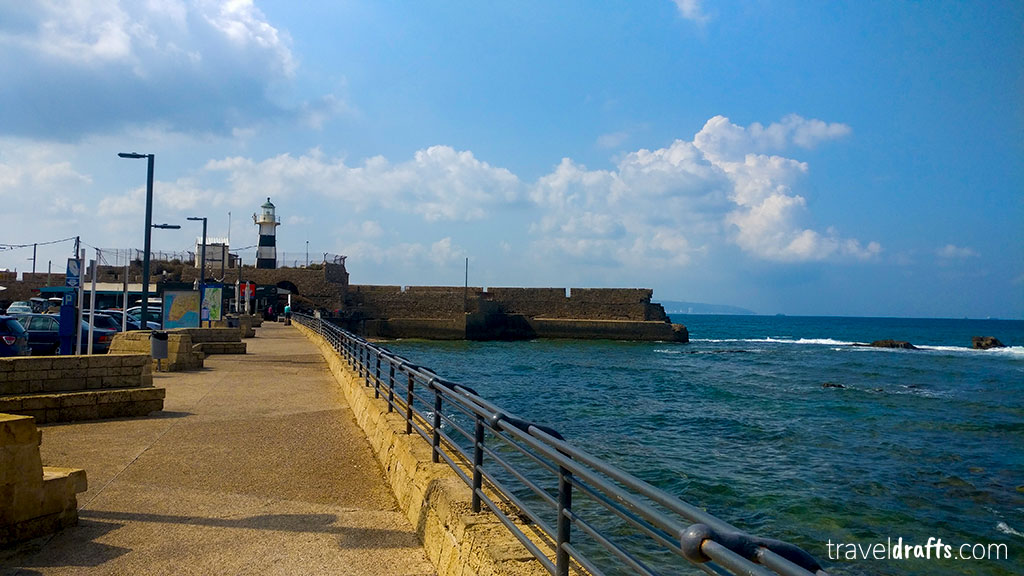
#9 Go to the Beach
Despite being right on the shore, Akko is much more famous for its history and port than for its beach. Akko isn’t a beach resort town, but it has a beach where you can have fun.
Argamon Beach is the best beach in Akko’s vicinity, and it’s conveniently located south of the old town and Port. We didn’t actually go to the beach because it was very windy and not very inviting to stay there, but we have read that it’s a very good Mediterranean beach.
#10 Go to nearby Haifa
Haifa is a much bigger and even more famous city than Akko, though as a tourist destination, it isn’t as interesting. It’s not even a close contest… Yet, it has one very cool tourist attraction, the Bahai Gardens. The Bahai Gardens, by themselves, are worth the side trip from Akko to Haifa.
The gardens are the most important religious site of the Bahai and a UNESCO Heritage site. The best view of the gardens is from the viewpoint from the top of Mount Carmel, where you can see them. However, if you want to visit, you must go on one of the organized tours from the Bahai. There is no other way of visiting them.
The Bahá’í Gardens contain a staircase of nineteen terraces on the northern slope of Mount Carmel. At the heart of the complex stands the golden-domed Shrine of the Báb – the resting place of the Prophet-Herald of the Bahá’í Faith. The different sections of the gardens offer different experiences, with graveled paths, hedges, flowers, and trees.
The gardens also offer incredible panoramic views of Haifa, the Galilee Hills, the Mediterranean Sea, and even Akko.

#11 Eat some fantastic food
Akko is an excellent foodies destination. Well, all of Israel is, but Akko, in particular, offers excellent experiences for foodies. Besides the widely famous fish and seafood in Uri Buri that we mentioned earlier, you can have some fantastic food on the market and other street food joints.
We are huge fans of street food, and we usually have at least one meal daily. In Akko, we had the best Baba goulash of our lives, but the Hummus, the falafel, and Shawarma were also pretty good.
Unfortunately, Israeli food tends to be expensive, but falafel and hummus in the market are very budget-friendly, and in Akko, you have many stalls selling those. There you’ll also find many of the famous middle eastern sweets like baklava, kanafeh, or halva.

Best time to visit Akko
The climate in Akko is mainly Mediterranean, with hot and dry summers, while winters are mild and more humid. In Summer, the highest temperatures are in August and reach an average of 30º C; during Winter, the lowest average is in January at 17º C.
So, Akko is an all-year-round tourist destination. It’s never too cold, and despite the winters being wetter, it doesn’t rain that much. However, if you want sun and hot, then Summer is your best bet.
Finally, we must mention that Akko is a popular destination, but not too much. Even during peak season in Summer, you won’t get those unpleasant crowds of tourists – maybe avoid Summer weekends (Friday and Saturday) if you have flexibility. However, we wouldn’t worry too much about it.
Where to stay in Akko
Akko has a relatively small city, so you can easily stay in the center and walk everywhere. Or if you want to use the beach, you can stay in one of the hotels by the beach and then walk to the center.
Best hotel in Acre – close to the beach
If you want to stay by the beach, the hotel we recommend is Palm Beach hotel , which is right by the beach; it was excellent facilities and a delicious breakfast. If you are driving, it’s very well located, as you can easily park there. Check prices here .
Best budget hotel in Acre
The Akko gate hostel is probably the best budget option in Akko. It’s probably the cheapest option, and the rooms are fairly good with climatization, WIFI, and a private bathroom. Another good option is the HI – Akko knights hostel. Akko has many great things for a traveler, but budget accommodation isn’t one of them. There are very few budget options, so if you find a good deal, take it!
If you are now happy with any of these, you can have a look at some of the best hotels in Akko on booking.com .
Pin for later

Sharing is caring!

breaking news

The Knights Halls
Discover the mysteries of the famous underground city!

The Templars Tunnel
Walk in the footsteps of the Crusader Templars!
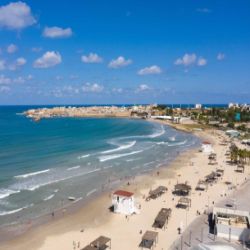
Argaman Beach
Catch some sunlight on Akko's stunning Golden Beach
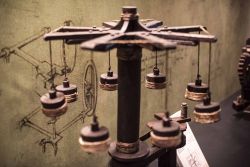
Leonardo da Vinci in the Knights Hall

MUSIC IN AKKO

The International Fringe Theatre Festival

From Baroque to Bjork
Restaurants & street food.
Akko is famous for its delicious food, from renown Chefs and incredible Seafood, to its savory Hummus you won't want to miss.

Famous for Hummus

A Doughy Paradise
Akko routes.
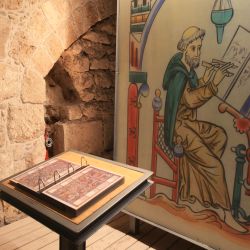
The Classic Route
- Historical site
- Walking route
- For families
- Full Signage
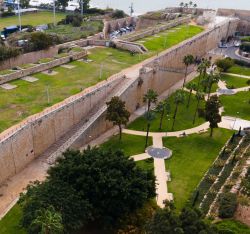
The Walls Route
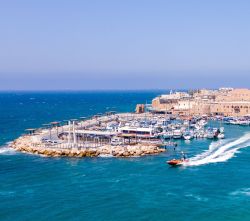
The Maritime Route
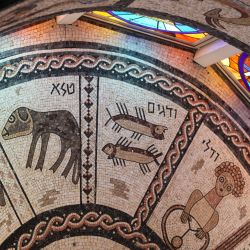
The Jewish Route
- Partial Signage
booking tickets
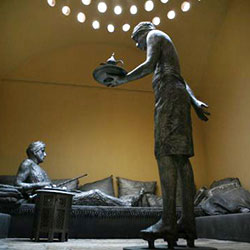
The Turkish Bath House
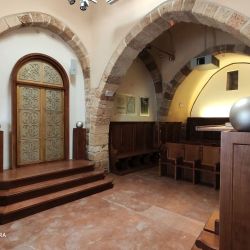
Ramchal Synagogue & Visitors Center
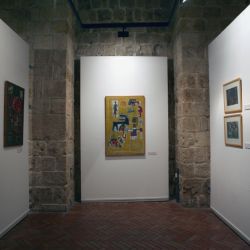
The Okashi Museum of Modern Art
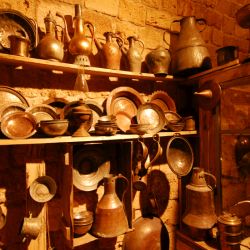
The Ethnographic Museum

Rosh Hanikra
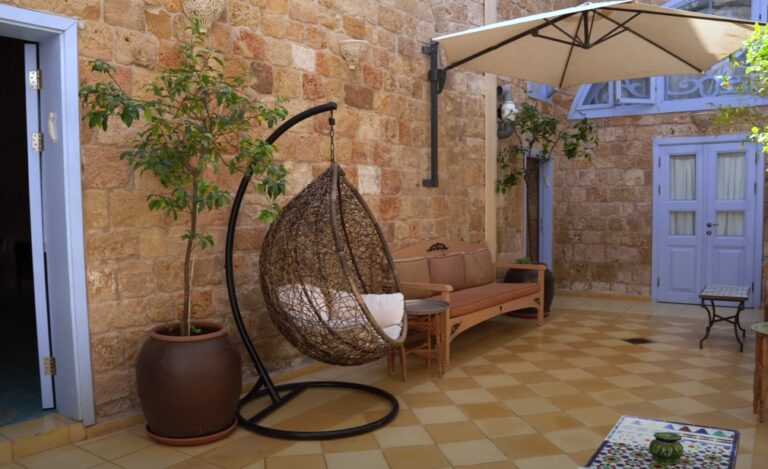
Hotels & Vacation rentals
Around akko.
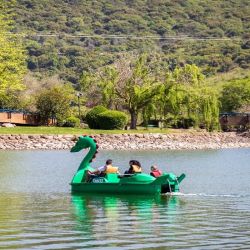
Monfort Lake
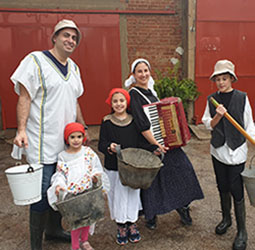
Kibbutz Kfar Masaryk
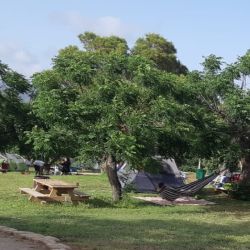
Akhziv National Park
Akko with a local.
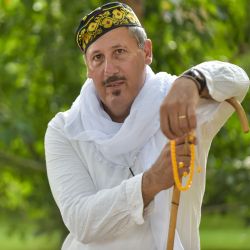
Experience 'Muza Muza' with Abdu, the Musical Folklore and MUSE of Old Akko
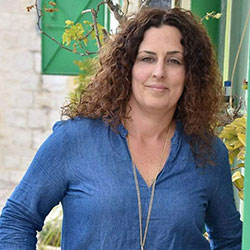
Join the experience of authentic flavors and aromas that set Akko apart

Meet Beit Elfarasha
Get to know the El-Farasha House, learn the secrets of the Akko authentic cuisine from the unique women’s team of El-Farasha House

Meet Judith
You are welcome to enjoy the special diversity of Old Akko with a 'mixed Akko' tour
#TravelAkko

Roslana recommends the knights halls

Miri Mesika

Happy Travel

Caitlin Sakdalan

Food Bloggers USA

Anaelle Hot Couture
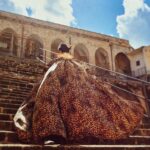
Einav Fitness training
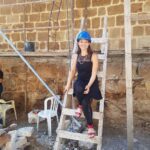
Inbar in old akko tour
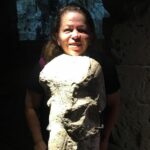
Orit is enjoying the Knights Halls

Einav Fitness training in the fortress cortyard

Shlomi from Akko pictures his city with love
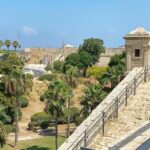
Mor enjoyed Akko "the city walls, a breathtaking view"

Deep down you are ready

I am super pleased with the results of our second part of this collaboration
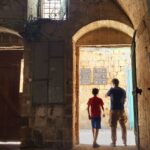
Naama hamamlitza recommends "my family men in Akko"
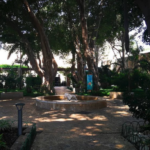
Revital.israeltourguide invites you to enjoy the Knights Halls, Old Akko

Bar Sheleg content creating & social media was surprised from our huge Knights Halls

Yuval Malchi visited & raved… and now is planning the next podcast about the Knights Halls

They came to Miss Universe beauty pageant and admired Old Akko's sites

Worldwide ambassadors enjoying Old Akko sites and the … ducks

Teona visits the Knights Halls in Old Akko and tells friends about it
- Hotels & Vacation rentals
- Accessibility
- Opening Hours
Accessibility Menu

Our guide to the things to see and do in Akko (Acre)
- 100 Facebook
- 108 Pinterest

Acre’s rich history has meant a long list of cultures playing an important role, including Israelites, Greeks, Romans, Crusaders and Arabs. Acre is also a holy city in the Bahá’í Faith and can add recognition by UNESCO as a World Heritage Site to its impressive resume.
It’s not exactly on the main tourist trail, but there are plenty of awesome things to check out; definite must-sees in Acre include the Old City, with its shabby glamor and funky open-air market, the Hospitaller Fortress where you feel like you’re walking in a time warp C.E. 1230, and the marina, with its fishing port and lighthouse.
This excellent map shows Acre’s must-see attractions, but be warned: unless you have superhuman energy, you won’t be able to fit everything into one day of touring.
The most organized way to tour is to go to the Old Acre Visitors Center, located in the Old City at 1 Weizmann Street, in the Enchanted Garden area (or otherwise park in the main Lighthouse parking area, where you can enter the Old City via the underground Templars Tunnels). In the Visitors Center you can buy tickets combining the places that most attract you.
Must sees in Acre
Not to be missed is the Hospitaller Fortress . There, you can wander through the enormous stone rooms with vaulted ceilings and perfect acoustics (try singing if you have a good voice!). The spectacular dining hall, dormitories and even ancient latrine are in good shape and worth visiting.
In the large open courtyard, you can almost hear knights practicing their swordplay, loaded donkeys being led into the stables, and servants bustling back and forth from the well. The well is there, a keyhole-shaped structure now wisely covered by netting. A thriving caper bush grows inside. The well fills up twice daily, when the rising tide pushes the fresh-water source back upland.
If you want a feel for a real person who lived and died in the fortress, visit Peter’s headstone on the way out. The Latin inscription and portrait of the knight etched onto the stone make you feel like you almost know this old Crusader.

The Turkish Bath House , one of the many layers of Acre history to walk through, is perfectly preserved. Colorful tiles walls enclose the space where all the important men came to steam their troubles away, while their wives held parties in a separate enclosure. There’s also an entertaining movie that explains the history of the Bath House, inseparable from the history of Acre itself.

Once you’ve walked through the market, head down to the Acre marina for some sea breezes and a wander past some of the old fishing boats. If you’re feeling particularly touristy, be tempted by the hawkers selling you a ride on one of the tour boats. At ten shekels a person, it’s a great little ride out into the deeper waters where you get a terrific view of the Old City walls.
Other things to see in Acre
Outside the Turkish Bath House and down some old stone alleys, you’ll come to a street that has cafes, souvenir shops, a post office and an ATM. Art lovers will enjoy going through the nearby Okashi Art Museum. Return your audio equipment to the ticket office if you’ve rented some. Take a rest in the shade of a palm tree. Visit the Al-Jazeer Mosque, if you’re so inclined. Then you’ll be free to wander over through the colorful Old City and open-air market.
Tips for tourists
If you’re stuck for time and not sure what to squeeze in to your visit, get a guided tour. A friendly, well-informed guide makes the experience come more alive. Bring a battery-charged camera and extra batteries. Bring at least half a liter of water to drink. If you need a nosh every once in a while, put a couple of small snacks in your backpack.

White Night in Tel Aviv: the ESSENTIAL guide!
The Old City locals are used to tourists, but they’re poor, conservative people, mostly Muslim. Respect their space and don’t wear outrageously immodest clothing (women), don’t snap photos in people’s faces, and don’t raise a lot of noise as you walk in their neighborhood.
Getting to Acre
Akko is fairly easy to get to as it lies just north of Haifa and is on the main rail route (which is perhaps the nicest of the travel options to Akko). Trains run every 20 minutes at peak hours, while buses are just as frequent, though you may need to change at major transit points Carmiel or Haifa, depending on where you are coming from. There are also service taxis from Haifa that are just as cheap as the bus; head to the Hadar neighborhood or Herzl Street to catch one.
Eating in Acre
There are hummus and falafel places all over the Old and new City, and these are probably your best bet for some quick, fun dining. The best-known hummus joint is Said, in the market of the Old City. At the marina there’s the famous Uri Buri fish restaurant and the Galileo Restaurant. Neither are cheap, but said to be very good. Kosher-keepers will have to taxi into town. At the time of this writing, you should pay no more than NIS14 to get from the marina into town.
Two good kosher restos: Ushpizin on 17 Hasapanim (04-981-0022), a Mediterranean meat grill place; and HaShalom for fish at 20 Haarba Road, Acre. We can recommend Ushpizin for high kashrut standards and cleanliness. Food good.
Where to stay in Acre
Hostels in the Old City and nearby are cheap but not known to be especially clean. For comfort, privacy and security, B&Bs outside of Acre are a better bet. There is one hotel, the Palm Beach, which boasts a spa and 4-star accommodation. Here’s a full list of the best options available.
Check out our clip of Akko below for a real taste of the city…
Akko in Israel, called Acre in the Bible: Exotic, Authentic, Unforgettable
:max_bytes(150000):strip_icc():format(webp)/Karen-Tina-Harrison-Macchu-Pichu-56a5cb7d5f9b58b7d0de80ff.jpg)
TripSavvy / Lauren Breedlove
Akko , the place called Acre in the Bible, is one of the most thrilling spots in Israel. It's like nowhere else, with spectacular sights, stirring history, and an intensely exotic aura.
However you refer to it, (Akko, Acco, or Acre), being inside this Biblical port city's ancient stone walls is unforgettable. Visitors are dazzled by Akko's winding narrow streets, mysterious passageways, towering minarets, and muezzins' chants calling Muslims to prayer.
Akko's Old City, whose port dates back at least 4,000 years, is set on a tiny peninsula. You can walk from one side to the other in under 20 minutes, and see over a thousand years' worth of unsoiled landmarks. In the pages of this story, you'll preview many of Akko's incredible sights.
Where Is Akko?
Akko is in the northeast of Israel, set in a Mediterranean bay directly across from the major port city of Haifa. Like every place in this compact country, Akko is easy to get to .
A Holy City in the Holy Land, Meaningful to Four Faiths
Old Akko is especially distinctive in Israel because it shelters sacred sites of four faiths: Christianity, Judaism, Islam, and Baha'i.
- In the Baha’i faith, Akko is the holiest place of all. The founder, Baha’u’llah, lived just north of Akko, and the Baha’i Founder’s Shrine & Gardens are nearby
A UNESCO World Heritage Site
Akko's Old City is one of the world's 971 designated UNESCO World Heritage Sites, the real list of "places to see before you die."
Akko in the Bible
In Old Testament times, Akko was part of Judaea, the ancient Jewish homeland ruled by King David and King Solomon. (Find out more about Akko's vivid history as a crosroads of the world.)
Who Lives in Akko Today?
Akko residents speak of its pull, its mystique. The tiny, original Old City has 5,000 residents: Muslims and a few Christian Arabs.
Though this is Israel, there are almost no Jews in the Old City. They lived here until the Arab Revolt of 1939.
But just beyond the ancient walls is "new Akko," whose population is about 70% Jewish. • Most of these Jews came to Israel from Northern Africa in the 1950s and 60s • Today, Russians, French Jews, and North Indian Jews (" B’nai Menashe ") are also settling in New Akko
Intrigued? Here's Some Advice
Akko asks for your time and attention: to climb the Citadel steps, to watch real belly-dancers, to hear Ottoman music, to get your fill of clean Mediterranean air at seaside cafés.
• Many tourists go to Akko for the day (or even a half-day} • Consider staying longer, and luxuriating for a night or two at Efendi Palace Hotel, a former pasha’s mansion, and the only luxury boutique hotel in the Old City
Get Your Akko Bragging Rights
Akko -- unique, multicultural, ancient and flavorful -- is on the cusp of rediscovery. I was told by a resident, "Akko is a gem in the rough, just now being polished." • Akko Visitors' Center's practical advice
Akko, the Crusaders' Capital in the Holy Land
Akko was the crusaders' base in the holy land.
Then known as Acre, the city was the Crusaders' stronghold in the time of the Holy Crusades, the 1100s and 1200s.
- Knights -- well-funded aristocratic adventurers -- from all over Europe converged on Akko
- Several orders of knights built their own headquarters in Akko. These included the Malta-based Knights Templar and the Benedictine Knights Hospitaller, who cared for the sick and wounded
- Civilians followed them, and established neighborhoods: French, German, English, Castilian, Venetian, Pisan, Genovese, and so on
- Akko once again became a thriving port, as in ancient times
The Crusaders' City is the Underground City
Much of what the Crusaders built is still standing, yet most of it is now underground. Thanks to impeccable excavation and restoration done in the past 50 years, today's visitors can marvel at and tour Old Akko's subterranean Crusader City.
Top of Your Must-See-in-Akko List: The Crusaders' Fort
You can walk through the Crusader Fort, atop its ramparts, and through its imposing vaulted rooms.
- This vast stone structure was built over hundreds of years with locally quarried stone
- The Crusaders built their fort with cathedral-like high arches that come to a point; to me, they resembled hands clasped in prayer
- The Crusaders were defeated and driven out in 1291
- Their fortress was left in ruins until the end of the 1700s, when the Ottoman Turks took Akko and built on top of it
Beyond the fort's Central Courtyard are several halls.
- They include the Knights Hall, the Hall of Columns, the Hospitallers' Hall (shown), the Pillars Hall
- Your Crusader Fortress ticket includes the Turkish Bathhouse and the Templars Tunnel, one of the world's most incredible medieval experiences
- The Prisoners Hall is a riveting part of the fortress. In this medieval gaol, you can still see the square holes in the wall that once held heavy chains for prisoners' manacle
- Crusaders' Fortress website
See more of Prisoners' Hall >>
Akko's Underground Prison Museum
Wikimedia Commons/Amos Gal
Right above and across from the Crusader complex, almost a part of it, is a notorious jail, underground. Today it is the...
Museum of the Underground Prisoners
Its backstory: In the first half of the 20th century, Palestine's British overlords repurposed the Citadel of Acre's fortress. They used it to imprison Jewish settlers who struggled against Britain to establish modern Israel.
- Jewish Underground freedom fighters (Hagana), and Arabs as well, were imprisoned here between 1920 and 1948
- Among the prisoners: Zionist leader Ze’ev Jabotinski and Moshe Dayan, the eye-patched soldier who aced the Six-Day War in 1967
- Eventually, Hagana's cause triumphed, and Israel was founded in 1949.
Now a museum, this intimidating stone edifice uses life-size metal statues to show what prison life was like.
- This is a dramatic place, especially the court-martial room and a wall of photos of those who died here, including an old, bearded Orthodox rabbi deemed a danger to the crown
- The Hanging Room is presented intact, complete with gallows
- The museum offers a well-produced video about the prison, including historic footage
- Museum of the Underground Prisoners website
See the dazzling synagogue where Akko's North African Jews worship >>
Akko's Tunisian Synagogue, Treasured for its Mosaics
Wikimedia Commons/Mattes
Akko's Tunisian Synagogue: A Celebration of Jewish Pride
For Jewish visitors, Akko's most exciting place may be the modern Tunisian Synagogue, a mere seven-minute walk from the Old City in "new Akko." It was built in 1955, and is exuberant with Israeli pioneer spirit.
This place of worship, also known as Or Torah Synagogue or Synagogue of the Mosaics , is resplendent inside and out. Its floors, walls, and ceiling, even its dome, are composed of small stones from all over Israel, creating mosaics.
- These echo the ancient mosaic floors of 2,000-year-old synagogues excavated in Israel
The mosaics give information in pictures, just as ancient mosaics did. They tell stories of:
- Akko’s history
- Jewish history and holidays
- Bible tales
- Israel’s holy cities: Hebron, Safed, Tiberius, Jerusalem
- The coins of Israel…and much more.
The synagogue's silver doors protect the doors to the Ark, which shelter Torahs brought from Tunisia's Sephardic community.
- Those hand-hammered sterling doors celebrate Jewish history, such as the fight for statehood (whose heroes were imprisoned in Akko), and the European Jewish communities annihilated by the Nazis
Stained-glass windows spotlight the State of Israel, depicting the Knesset (senate) and the symbols of Israeli Army regiments.
When the synagogue was established, there were no Jews living in Akko, either the Old City or the New. Rabbi Zion Baddash, the synagogue’s leader, told me, “Today, 54,000 people live in Akko, and two-thirds are Jews with 100 synagogues.”
Now it's time to visit Akko's most renowned mosque >>

Al Jezzar Mosque in Akko, Israel
Wikimedia Commons/MartinVMtl
A Big-Influence Mosque for Tiny Akko
For Muslims, Al Jezzar Mosque is the #2 mosque in Israel, its biggest and most significant, after Al Aqsa on the Temple Mount in Jerusalem.
- Al Jezzar is set just across the street from the Crusader complex
- It is all original, and feels like a trip to another time
This graceful house of prayer was built in 1784 by the Ottoman Turkish pasha (governor) of Akko, Ahmed Ja’azaar or Al Jezzar. The mosque is a complex whose buildings are still actively used by Akko’s Muslim residents. They pray here five times a day, facing southeast toward Mecca.
- The mosque impresses with its marble walls, arabesque designs, arches, chandelier, and red carpet with a square for each worshipper
- The mosque shelters a treasure a hair believed to be from the beard of the Prophet Muhammad. It is taken out once a year, at Ramadan
Who Was Pasha Ahmed Al Jezzar?
- This powerful ruler of Akko was born a slave in Albania or Bosnia
- He escaped, converted to Islam, and began his career as a strongman for the powerful
- He was nicknamed "the butcher;" see a dramatic bio
- Al Jezzar, in all his fierceness, held off Napoleon's siege of Akko, shaming the French Emperor
- He built important structures in Akko; the mosque is the most outstanding
- He and his successor are entombed at the mosque
See the Turkish Bathhouse that Pasha Al Jezzar built >>
The Turkish Bathhouse & Akko Municipal Museum
Israel Tourism
TheTurkish Bathhouse and Akko's Municipal Museum...
...are one and the same.
Around the corner from Al Jezzar Mosque is the hammam, or Turkish bathhouse, from the 1780s. They were both built by an Ottoman ruler of Akko, Pasha Al Jezzar, as part of the Al Jezzar Mosque complex.
The bathhouse is no longer used, and is part of Akko's museum.
- The bathhouse was designed in flavorful High Ottoman style, with authentic rounded arches and circular rooms
- Bathing was done not in tubs or pools but with steam, a style still associated with Byzantine cultures
- For visitors' added visual excitement, statues of "bathers" lounge about, like hammam patrons of their era (see photo above)
- Here you’ll find exhibits of antiquities, a history of Akko, and changing art installations
- A multimedia sound-and-light show plays all day
- Bathhouse/Museum website
Pasha Al Jezzar also built Akko's khans, or caravanserais. Its what? Come see >>
Akko's Impressive Khans: Its Caravanserai Inns
Wikimedia Commons/Adi Diamant
You've heard the word caravanserai. Akko is a good place to find out what that is. As you might guess, caravanserai (singular = caravansary) comes from the word caravan.
- Caravan: originally a Persian word meaning " merchants' camel train"
- Caravans transported goods on Silk Road trading routes between Europe, the Middle East, and Asia
- Caravanserai: a gated compound that provided overnight accommodations for the caravan, with stables and locked storerooms below and guest rooms above. (Many historians consider them the first hotels.)
- From About's Archeology Expert, more about the caravansary
Who Built Akko's' Caravanserai?
Hoping to drum up international trade, Akko's most powerful Ottoman ruler, Pasha Al Jezzar, built caravanserai. Of Akko's several extant examples, Khan el-Umdan, Inn of the Pillars, is the most imposing.
- It was built in 1785 by the Pasha, who also constructed Al Jezzar Mosque and the Pasha Turkish Baths
- In this period, Akko was a busier seaport than an overland travel hub; the inn is beside the port
- Its august pillars are columns that were taken (or looted) from the ruins of Caesarea, the Roman conquerors' provincial capital in Judaea
- Khan al-Umdan's web page
The more you know about Akko, the more you love it. A virtual visit to its "people museum" >>
Akko's "Real People" Museum
Akko ethnographic and folklore museum: crash course in akko culture.
Also known as the Treasures in the Wall Museum, this museum features everyday objects in a new light. This is a museum that depicts not the movements of kings and Crusaders, but the ordinary people of Akko.
If you sometimes wonder how real people lived in a particular time and place, this museum will fascinate you. It will show you objects that Akko residents used every day,
- They encompass olden times (from heavily embroidered Arab dresses and Oriental slippers; Persian copper dishes, farm tools, a beautiful display of padlocks
- From more recent times: typewriters with Hebrew keys, metal fans, cooking implements
- Other areas of the museum recreate whole rooms (I loved the Palestine-era Tel Aviv pharmacy, including its prescription book)
- A room of lavish furniture made in Damascus, Syria of shells, bone, and wood (Damascus was a trading stop on the Silk Road, and renowned for its artisans)
- Museum website
A 300-year-old synagogue named for its rabbi, a Kabbalah master from Italy >>
Ramhal Synagogue: Honoring a Rabbi with a Kaballah Name
Ramhal synagogue, a magical place.
Close by the Central Market (souk) in the Old City is a tiny, unprepossessing synagogue that one would hardly notice. But Ramhal Synagogue is very special, particularly to followers of "Jewish magic": Kaballah.
The temple is named for Rabbi Moshe Haim Luzatto, better known as the Ramhal, a noted Kabbalist who came to Akko from Padua, Italy in 1743.
- The Reb's Kabbalistic name, Ramhal, comes from Ra bbi M oshe Ha im L uzatto. (Kabbalah wordplay figures in many rabbis' nicknames, like the Maharal of Prague, from Rabbi Judah M oreinu ha - Ra v L oew) and Maimonides (Rambam, Ra bbi M oshe b en M aimon)
There is no women’s section; the ladies stayed outside on the street to hear the service. But Ramhal Synagogue no longer an active shul for either gender.
- Nevertheless, the rabbi is present on weekdays to talk to visitors
- And the temple's treasure is there to be admired: a Torah inscribed on deerskin by Ramhal in 1740 right here in Akko. It's on the bottom left of the photo above. (Here's a closeup )
- More about this unique Ramhal Synagogue
As atmospheric as Akko is, it's still a port where you can stroll the waterfront and savor wonderful seafood >>
The Port of Akko: Ancient Door to Asia, Now a Delicious Kitchen Door
PikiWiki Israel Project
Akko's Seaport, Crossroads of the Ancient World
Akko’s well-placed harbor, jutting into the Mediterranean, perches at the crossroads of Egypt to the Golan, Lebanon, Damascus, and beyond. This stategic setting ensured Akko's place in the history of every era.
Some famous historical figures who came to Akko by sea:
- Julius Caesar
- Mark Antony and his love, Queen Cleopatra
- Benjamin of Tudela , a Spanish-Jewish adventurer who visited and wrote about Asia a century before the better-known...
- ...Marco Polo, who began his overland journey to China here
- Richard the Lionhearted
- Francis (later St. Francis) of Assisi
- Jewish scholars including the Spaniards Maimonides (Rabbi Moses ben Maimon) and Rabbi Moishe ben Nachman, in 1164 (his Kaballah name was Ramban, now the name of a wharf in Akko's port)
Sailing around Akko
- You can take a sail around the bay aboard the 200-seat touring boat, Queen of Acre
- Or you can rent the luxury yacht Manyana , which holds twelve adventurers
Lounging at Akko's Port
The port is filled with the sights and sounds of any Mediteranean port
- The water shades from seafoam-green to turquoise to sapphire-blue
- You can join the locals and stroll along the walls of waterfront promenade called Ha Hagana. Its ancient walls are still intact
Dining at the Port: Uri Buri Restaurant & More Greatness:
- Further along, at the western port, Uri Buri Restaurant is famous for its creative seafood and fish dishes. This 400-year-old eatery is now owned and run by an Israeli celebrity chef, Uri Jeremias, who also owns Akko's stylish Efendi Hotel
- A review of Uri Buri: No Frills, Fantastic Fish
- A few doors down is Endomela, a small shop that sells Uri Buri’s homemade ice cream. You can also catch a cappuccino or Turkish coffee (espresso) here
Akko's shopping is like nowhere else, with handcrafted things to wear, eat, and smoke >>
Akko's Souk Market & Turkish Bazaar
Norma Davidoff
Akko's Souk, or Central Market: Just What You Hoped For
This genuine, intriguing, vibrant souk, or Middle Eastern open-air market, sells a bit of everything.
- Amongst other offerings, you can buy colorful spices; sesame and rosewater-scented candies; essential oils; beads and hamsa charms
- Check out the narghiles (hookah pipes) at the market. (I don't recommend bringing one home to an American airport, so have a smoke at a shop)
- Try on a fez (Buy one, and be mistaken for a jazz musician back home)
- Haggling is expected. Here on Luxury Travel, how to bargain at a market
Snack your Way through the Souk
- Hummus Said is considered one of the best in Israel. You'll have to line up to dine on the marquee item; if you don't want to wait, go around the back way for takeout
- At Kashash Brothers Sweets, try the baklava and kanafeh cheese pastry
Akko's Turkish Bazaar
This is not exactly a trip to the mall. The Turkish Bazaar's narrow stone passageways and small shops with wooden doors evoke the feeling of Jerusalem’s Old City souk. This bazaar, hundred of years old, offers souvenirs, rugs, chachkes of all kinds, and noshes.
- It is close to Akko's souk; you'll have to navigate a maze of streets, but look for the Turkish Bazaar signs
The bazaar's souvenirs tend to be trinkets. But the merchandise is better-quality at Galleria Suza , a gift shop with local crafts and Israeli products.
- More Akko markets and info
Stop for a nosh in the bazaar.
- Osama Dalal 's tiny eatery in the covered passageway is good for small plates of local recipes
- Across the way, Kukushka offers savory tapas-size snacks. Try the fried calamari and seared shrimp, with beer from the Galilee
- More Akko dining tips in the markets and beyond
Has Akko worked its magic on you? Find out about visiting >>
Find Out More About Amazing Akko in Israel
Excited about akko find out more.
Here are resources to get you started on an Israel visit, with Akko a must-see.
• Akko Tourism
• Israel Tourism
• Created by a passionate local, Akkopedia
• Akko on Facebook
• Here on Luxury Travel, Akko's eye-popping history
• An Akko photo gallery
• And pictures on Pinterest
• Akko Tourism has already planned your walking tours
• An Akko private guide I recommend: Roni Miyara
Top 15 Destinations in Israel
Where to Go in 2023: The Most Exciting Destinations to Explore This Year
One Week in Israel: The Ultimate Itinerary
Your Trip to Israel: The Complete Guide
The 19 Best Things to Do in Israel
Guide to Planning a Trip to Israel
The 18 Best Things to Do in Cairo, Egypt
Top 10 Reasons to Visit Israel
The Best Bathhouses in Istanbul
The 18 Top Things to Do in Meknes, Morocco
The Top 15 Things to See and Do in Morocco
9 Places for Jewish History in Paris, From Museums to Memorials
48 Hours in Cairo: The Ultimate Itinerary
The Top 25 Things to Do in Jerusalem
Top 10 Things to See and Do in Marrakesh, Morocco
The 12 Best Things to Do in Casablanca

9 Awesome Things to Do in Akko, Israel (Including a One-Day Itinerary)
- By Traveling Anne
- February 28, 2024
- In Israel Travel Advice
25 Comments
Traveling to Israel and wondering whether Akko should be in your trip itinerary? We've been to Akko (aka Acre) many times and I can assure you it should be. Let me walk you through this amazing ancient city and show you all the fantastic things there are to see and do in Akko.
In this post, I'll tell you a bit about the history of Akko, and then walk you through the nine main attractions this city has to offer. By the time we'll finish the list, I promise you that you'll want to incorporate this unique travel destination in your itinerary.
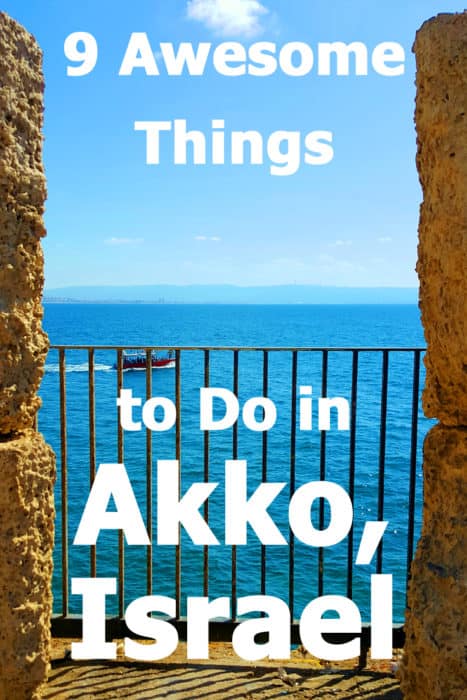
So, what is Akko anyway?
Akko is a city along the shores of the Mediterranean, home to about 55,000 residents. This is one of the few cities in Israel with a mixed population of Arabs and Jews. According to the city's website (in Hebrew), 72% of the population is Jewish and 28% Arab. However, you'll be visiting the Old City of Akko where almost all of the residents are Arab.
The Old City of Akko is a UNESCO World Heritage site and for good reason: The city is over four thousand years old! Archeologists keep discovering more and more of the awesomeness of that history - and you get to see it all when visiting.
Akko offers a thrilling mix of archeology, authentic Middle Eastern markets, the blue mediterranean sea, and some delicious ethnic food. It's a lot like the Old City of Jerusalem , only with a view to the sea. Let's start exploring what there is to do in Akko.
Is it Acre or Akko?
In English, it's known as Acre. Why? As far as my research shows, no one really knows. I can tell you that the name in Hebrew is Akko and in Arabic Akka. Some suggest that Acre is some version derived from the Canaanite word Adco which apparently means "border", possibly because this area was the northern border of the Canaanite territory.
But that was literally millennia ago. These days, you'll still see the name "Acre" in travel books and in signs in the city itself, so the word is certainly in use. However, if you're traveling via public transportation and need to ask a local about your destination, you should really use "Akko" (or "Akka" if asking a native speaker of Arabic).
9 Awesome Things to Do in Akko, Israel
If you're looking to create an itinerary, let's kick off the list of things to do. Make sure you read through for more tips that will help you plan the best possible visit to Akko.
1. Walk through the Halls of the Knights
A thousand years ago the crusaders invaded the Holy Land to conquer Jerusalem back from the hands of "the Saracens" - the term used at the time to describe the local muslim population. This was an age of romance and chivalry, when a knight in shining armour was a very real thing.
These knights built their own small town in Akko, complete with lively streets, thriving markets and a majestic fortress. They lived in Akko for a couple of centuries until the Saracens - lead by Sallah A Din - sent them back to Europe. Their cherished settlement was then covered in dirt and remained hidden from sight for centuries. It was only in 1990 that archeologists began to excavate the ancient town and bring it back to light. This ever-continuing extensive excavation and preservation project allows us to experience the amazing medieval town of the crusaders in a truly thrilling way.
Armed with an audio guide and a map, you are free to roam the excavated streets and alleys. Sounds and colorful moving images bring the streets back to life all around you for a unique multimedia experience.
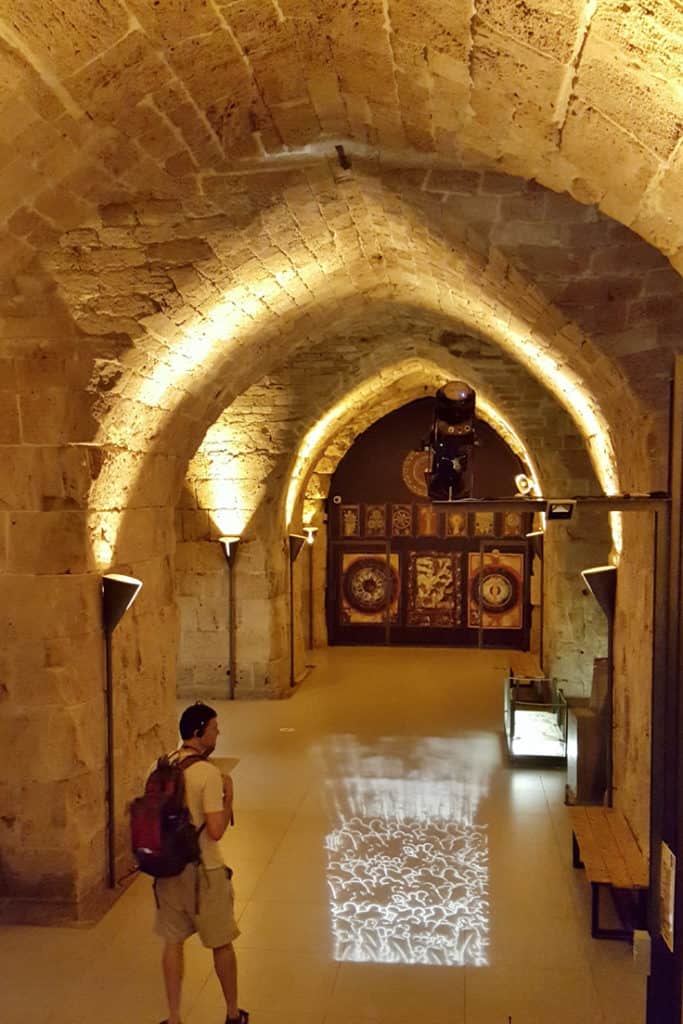
One of the tour highlights is seeing the great Dining Halls of the knights. You can actually have a wedding here these days, hence the huge tables and benches, medieval style. The original stone pillars and the colorful banners of the knights that surround you make it easy to imagine you've traveled back in time. Kids and grownups alike love these halls!

2. Visit the Medieval Market
Your visit to the Crusaders' Fortress will take you to a beautiful reconstructed market area where artisans engage in medieval crafts and arts. You can buy their art or just spend some time looking at them work. You are within the excavated city so the location couldn't be more perfect.
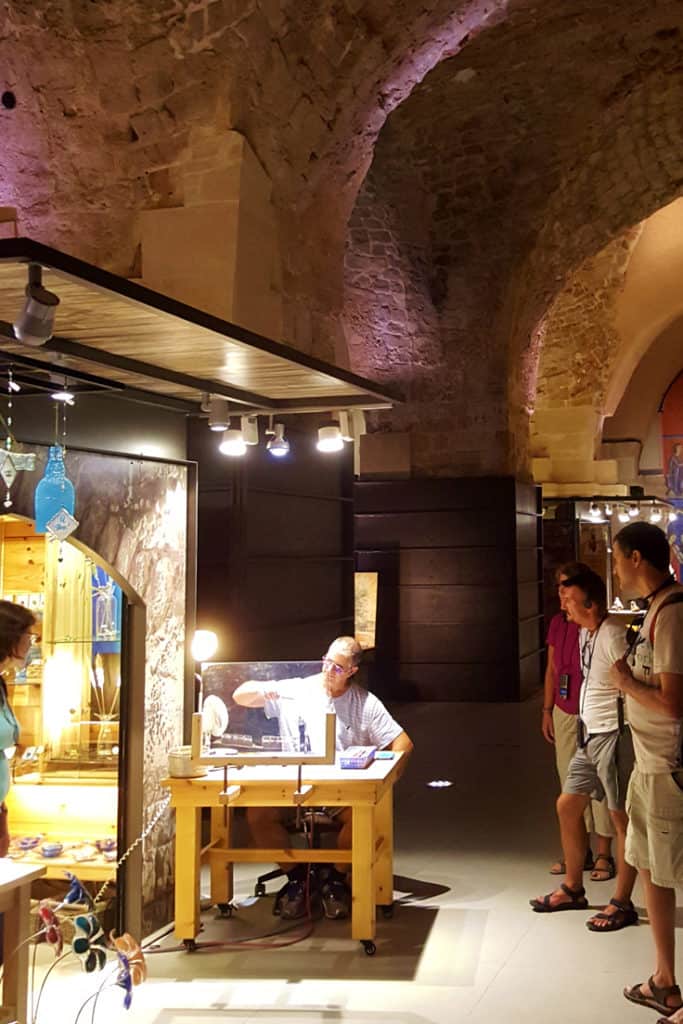
They even have game boards (rather than board games!) for the complete medieval market experience!
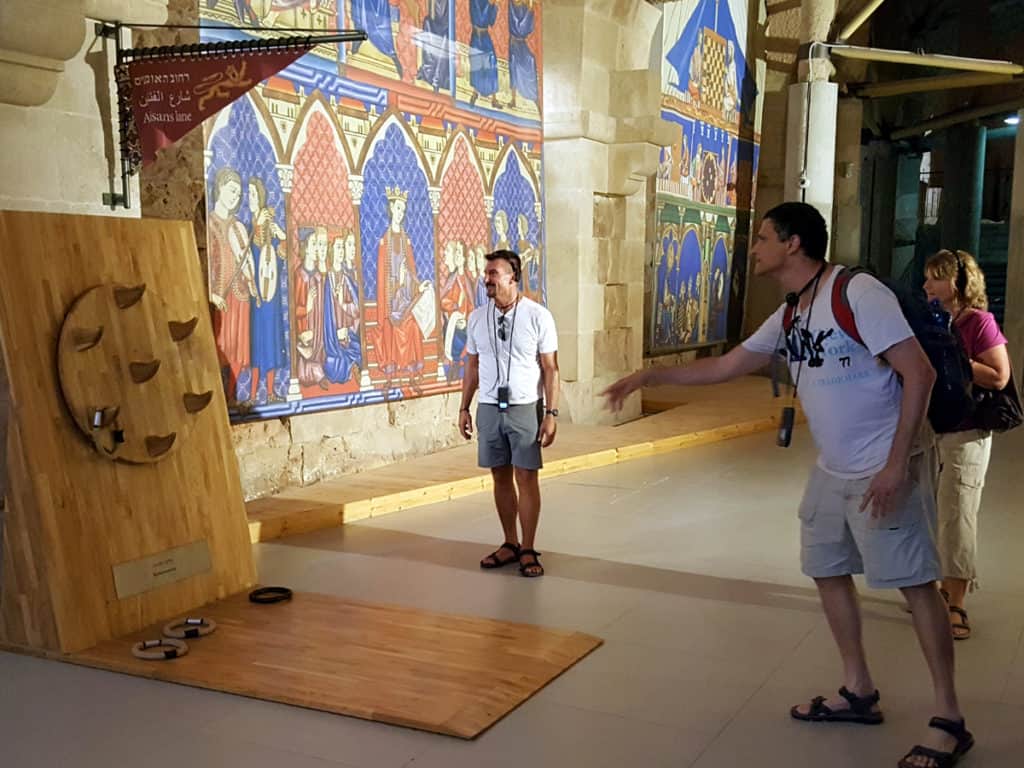
3. Follow the underground Templar tunnel
Indiana Jones meets the Da Vinci Code!
Have you heard about the secret order of the Templars? They too were here during the crusades and true to their secretive heritage they left their mark in the form of an underground tunnel connecting the fortress with the beach.
The tunnel was discovered in the 1990's and has since been fully excavated and made safe for visiting. There is sea water in the tunnel but fortunately they put in a wooden deck so you don't have to get your feet wet. You enter one end near the fortress and walk along the tunnel -
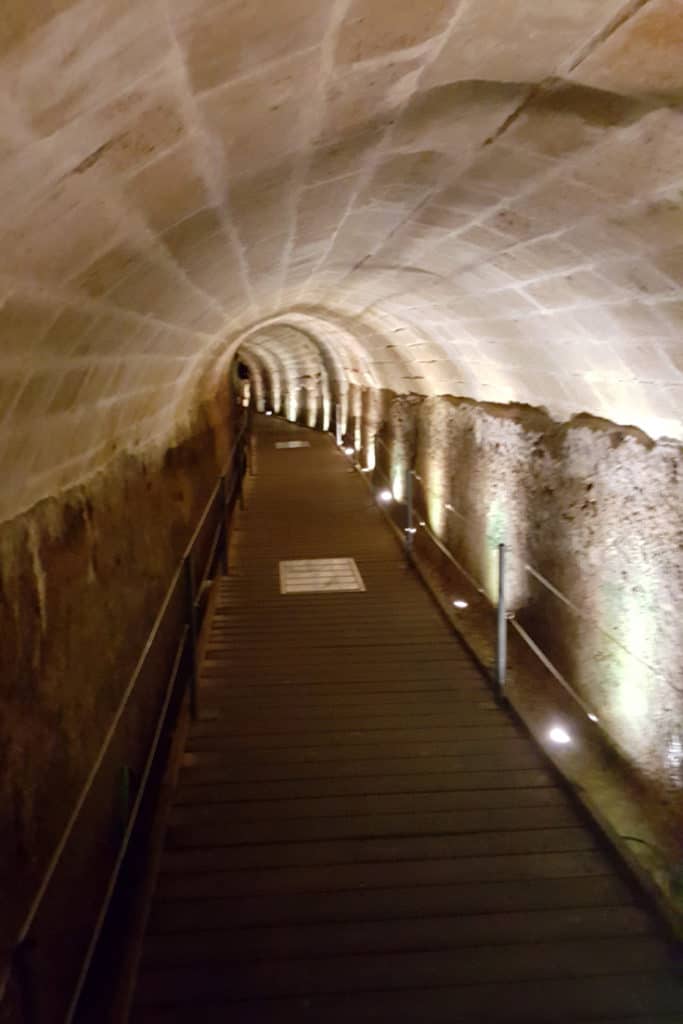
Which brings me to the next recommendation -
4. Breath in the sea air on the city walls
Akko was a historic port city of strategic importance. During the 18th and 19th century, its Ottoman rulers fortified the city with a strong stone wall built around it. Today you can walk along the wall for amazing views of the Mediterranean. It's not always very clean but the breeze and views are worth it.
Make sure you stop in one of the many observation points along the wall. Originally made for soldiers to shoot through, they now provide perfect photo opportunities. Try this suggested route along the Walls of Akko .
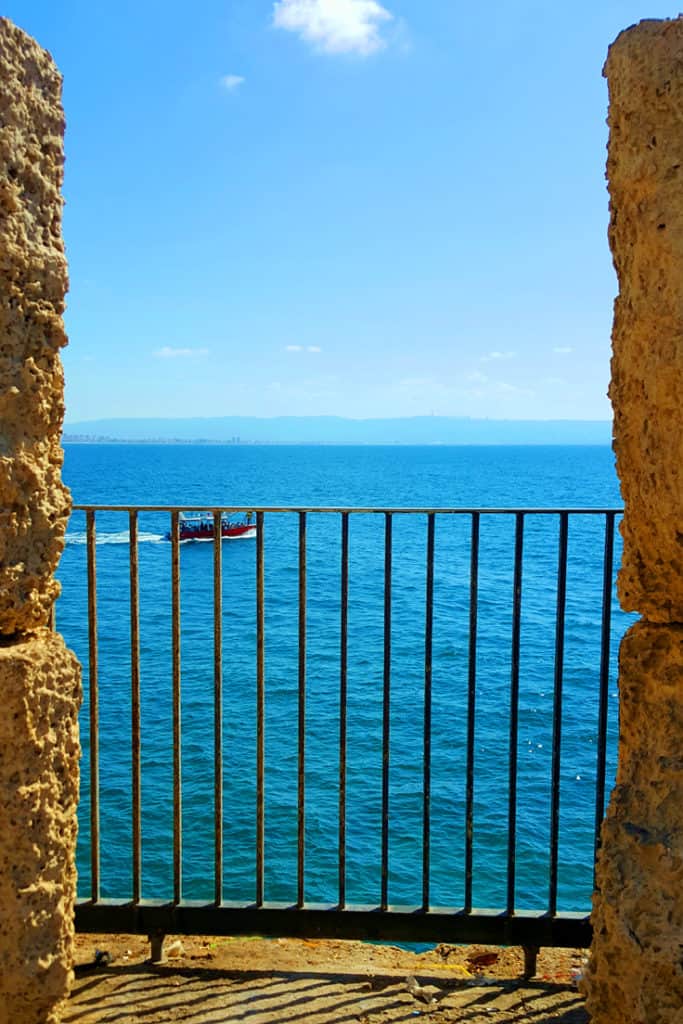
5. Taste the local food in the market
Akko is famous for its Old City bazaar. It's absolutely worth a visit in its own right, so make sure to immerse yourself in the colors, sounds, and scents of this fishing port's market.
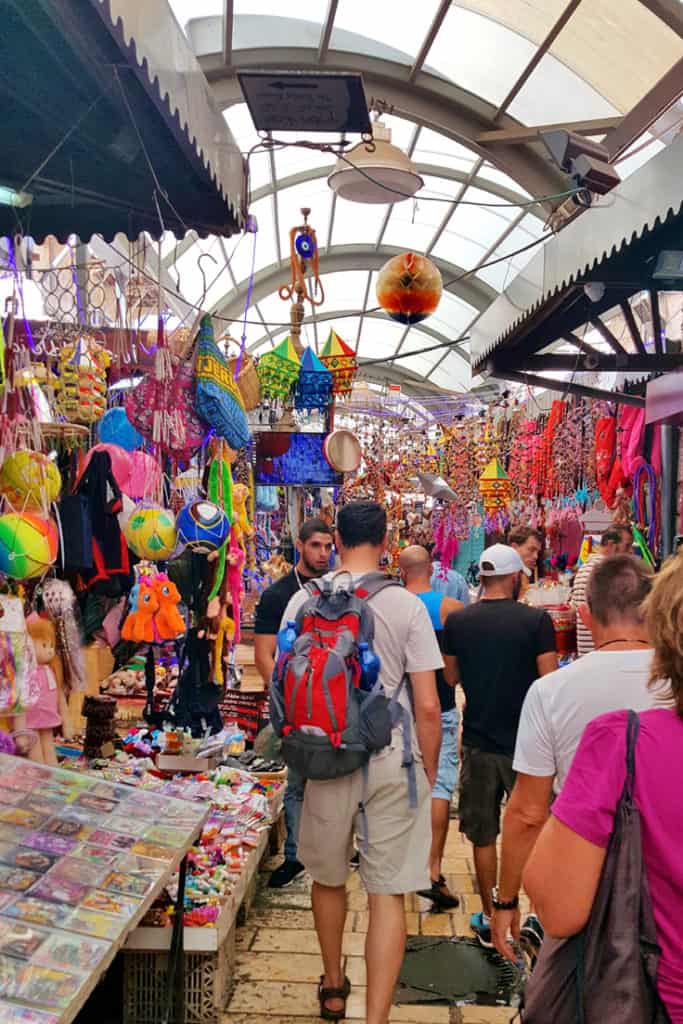
Sa'id's Hummus place is famous across the country and offers delicious fresh hummus with extras served with warm homemade pita bread. Yum! This is a popular lunch joint that can get crowded but that's part of the charm of this local experience. Don't be too late. Once they run out of hummus, they close for the day.
If you have a sweet tooth, you're in for a treat! Street vendors offer a variety of homemade authentic candy. These will preserve quite well so you can get a few pieces as gifts for your friends back home.
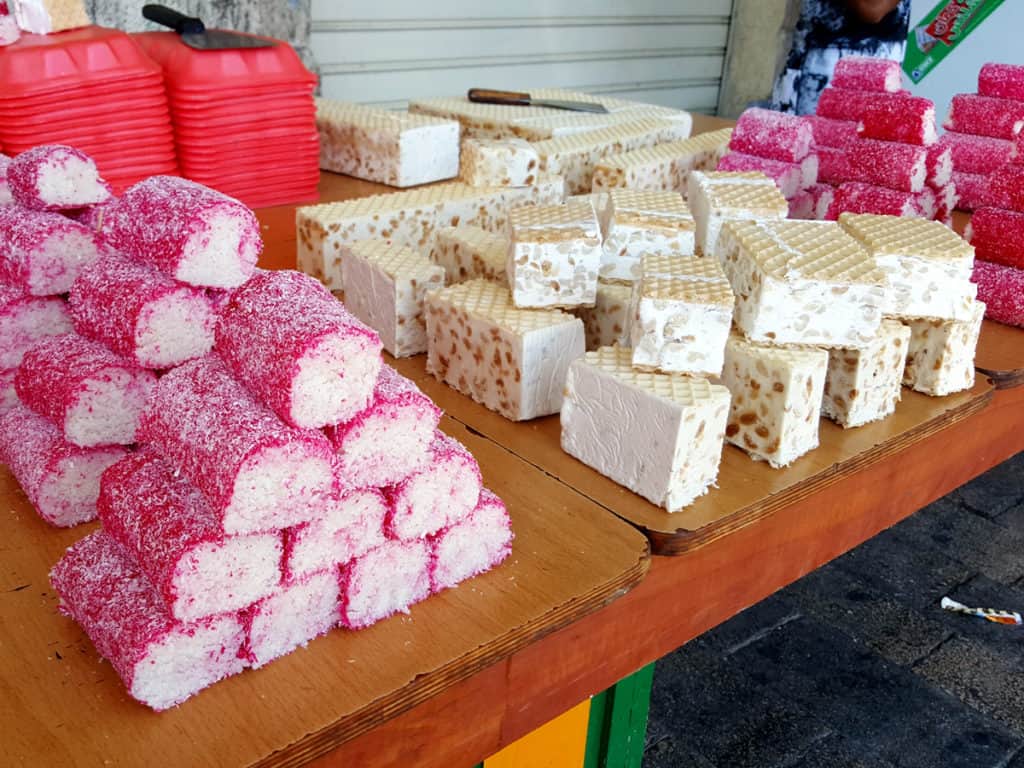
6. Visit the Hammam
The beautifully reconstructed Hammam is one of Akko's historic gems. Hammam means Turkish bath and this one was a center of local social life for centuries -
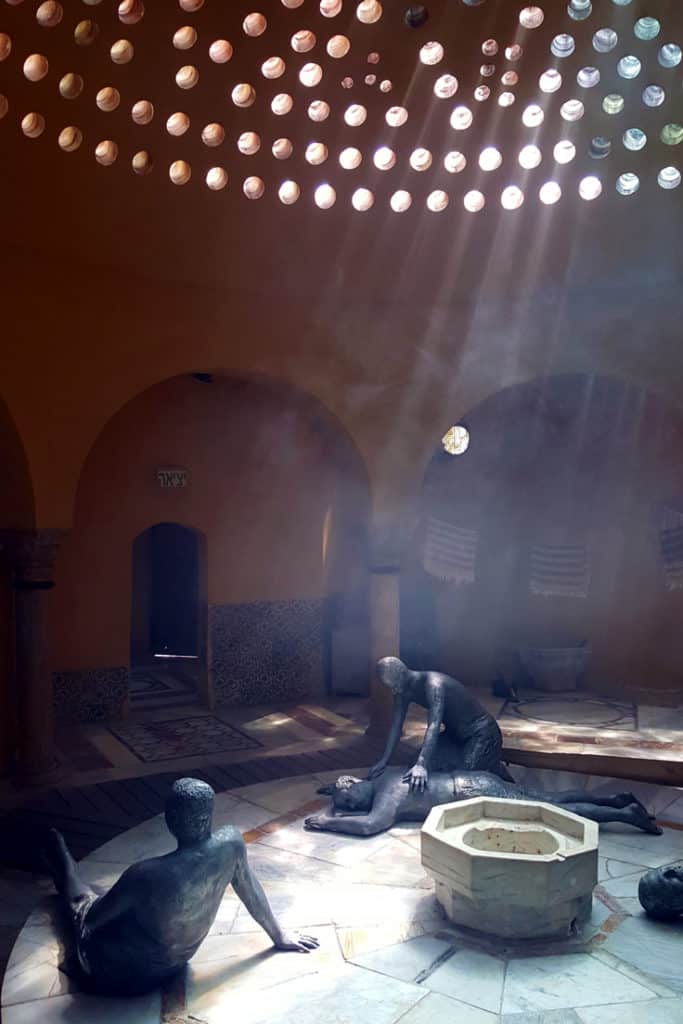
7. Enjoy a break next to the fountain
Need a break from all the walking? Looking for a place where you can sit down in the shade and nibble on the sweets you got at the market? Try the magical garden right by the visitors center (near the entrance to the Crusaders' Halls).
This is where your tour of Akko will likely begin and end. Sit by the small fountain under the canopy of old trees and just relax. There's a small cafeteria, vending machines and bathrooms nearby too.
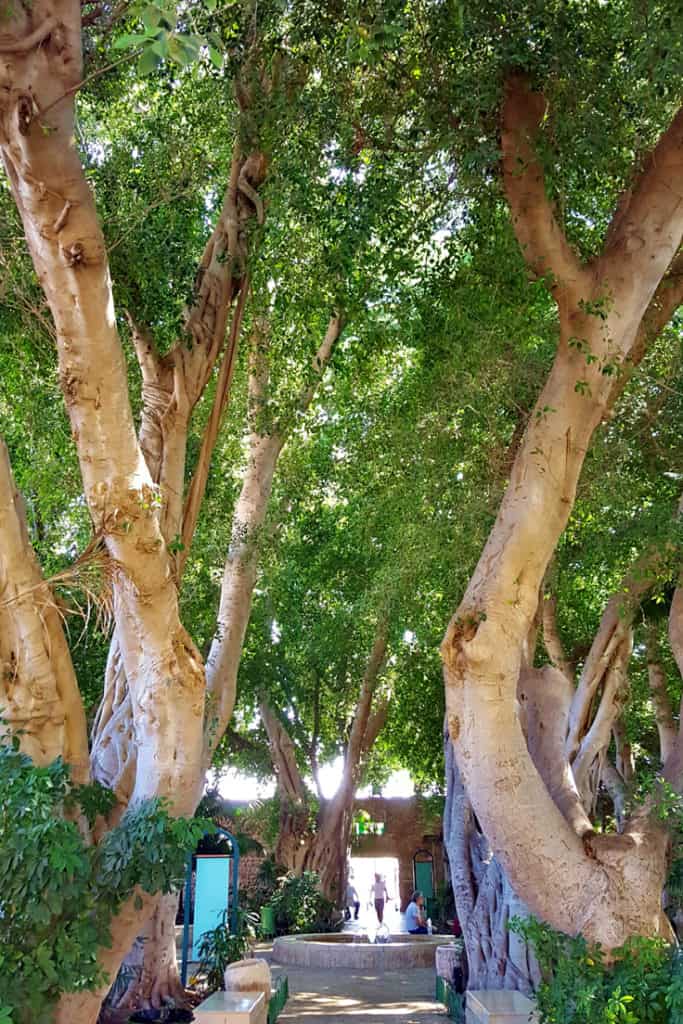
8. Climb the Ottoman cannons
Across the road from the visitor's center, you'll see another piece of the Old Wall. This one has real cannons too! Kids love climbing on these authentic cannons that date back to Napoleon's time. These metal weapons actually saved Akko from being taken over by the French emperor!
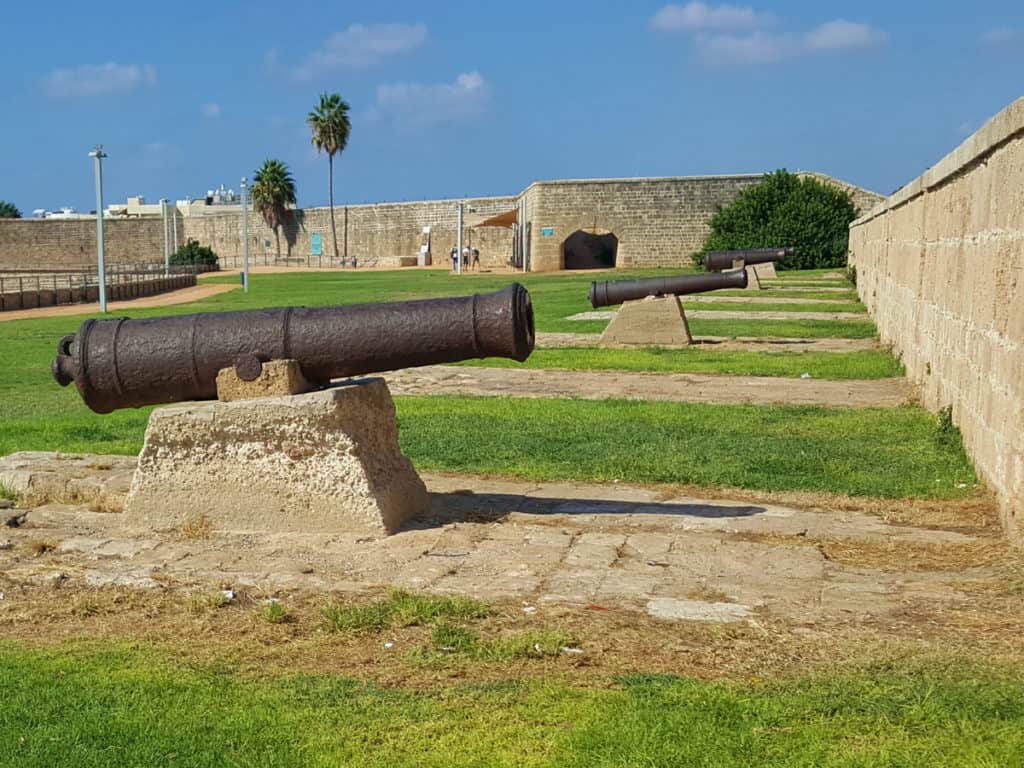
9. See a museum
Akko has several art museums and galleries that are well worth a visit. If you want to stick to the historic perspective, the Treasures In The Wall museum is your best bet. These rich collections of crafts and objects from various periods are on display literally within the old wall (hence the name of this museum). For modern art, try the Okashi Museum .
10. Enjoy the Akko Festival
Yes, I know, this post is supposed to offer you nine awesome things to do in Akko. Here's a bonus tenth item! This one is very seasonal, so maybe it should be numbered "nine and a half"?
Getting to the point, Akko is home to the Israeli Festival of Fringe Theatre . Every year during the Jewish holiday of Sukkot, the city turns into a local Edinburgh. The shows themselves are usually in Hebrew but there are many street performances outside too. The exact dates change each year according to the Jewish holiday calendar but if you're planning on visiting Israel during September or October find out if you can catch this very special festival.
When to visit Akko
If you have some flexibility with your dates, try to pick a weekday for your visit to avoid the crowds. Remember that in Israel, Sunday is a weekday but Friday isn't. So anytime Sunday-Thursday is good.
Summertime can be hot but not unmanageable. Indoor attractions are fully air-conditioned and there's almost always good breeze once you get on the walls.
How to get to and around Akko
I hope you're convinced by now that you should add Akko to your itinerary! It's really easy to get here and to get around town.
Traveling by car?
Akko is a short half an hour drive from Haifa or an hour and a half from Tel Aviv. There's ample parking by the visitors center where your visit begins at a reasonable fee of $5 a day. There's some free parking in the area but you could find yourself driving in the alleys of the Old City - a slow and nerve wracking experience you probably want to avoid. The address for your GPS is: 1, Weizman street, Acre.
Using Public Transportation?
If you don't have a car, you'll find that Akko is one of the easiest places to get to using public transportation. Not only are there frequent busses coming in from Haifa, there's even a train station. You can easily board a train in Tel Aviv in the morning and be in Akko at around 10AM to start your fun filled day and return back to Tel Aviv in the late evening. The train station in Akko is about a mile away from the Old City. Easy enough to walk but you can also get bus or a taxi if you prefer.
And now, you can even take the ferry to Akko! The ferry can take you from Haifa to Akko and back. It goes out twice a day in each direction. At only 55 shekels (around $14) each way, it's a great way to sail the mediterranean too.
Getting around while in Akko
Once in the Old City, just use your legs! Distances are short and with so much to see and do on the way, there's no point in getting any transportation. Most visitors choose a round route, getting to the walls by the sea via Templar Tunnel and returning through the busy colorful bazaar. Start at the visitor's center where they'll give you a map and help you with instructions. Don't worry about getting lost a little, it's part of the fun!
What to wear in Akko
Basically, whatever you want. You'll be walking in an area that's a bit more conservative than others in Israel but no one expect you to dress as a local. It can be hot during summertime so short sleeves and shorts are perfectly fine.
The one exception would be if you visit one of the mosques. Old Akko has several of them, the most famous one being the Al Jazzar mosque. These are working houses or prayer so if you're thinking of visiting, you'll have to find the right time slot (it changes daily). Your best bet would be to just get to Al Jazzar in the morning and ask about visiting hours for that day. Then walk around and return in time for your visit.
I'm mentioning all of this here because if you wish to visit a mosque, you need to dress accordingly. Long pants or skirt (covering the knees) and a long sleeve shirt or a shawl. No need for head covers, just to make sure your knees and elbows are covered.
And if you're still worried about dress codes, check out my 9 tips on what to wear while visiting Israel .
Where to stay in Akko
Your first question is whether or not to stay in Akko. It's a great day trip destination from Haifa and even from Tel Aviv. It can also be worked into any itinerary of the Western Galilee. That said, it's entirely possible to spend two or three days in the city to really soak up the atmosphere and add more museums and other attractions to your Akko trip.
If you decide to stay in Akko, there are many options to choose from. Backpackers and low-budget travelers should check out the Akko youth hostel that's perfectly located right by the visitors center. It's clean, spacious and comes highly recommended. If you can't find a room there, try the Akko Gate Hostel as another affordable option.
For families or couples, look into getting a vacation rental. They're a whole lot cheaper than what you might think and many are now available through Booking.com. I prefer working with Booking, as it allows me to keep my reservations in one place and work directly with a reputable company.
Here are some fantastic vacation rental options in Akko. Click through to see images, reviews, and prices for your dates. Or just search Booking on your own .
Sweet Little House - Located less than half a mile away from the Old City, yet in a quiet residential neighborhood, this small vacation rental gets excellent reviews.
Acre Two Wells Zimmer - A romantic place for couples within the Old City, right by the walls and the seaside. Modern amenities along with a fully renovated authentic interior - complete with two wells!
Four Hearts - Acre's Sea Side Suite - A magnificent rooftop apartment with a luxurious interior complemented by amazing views of the Mediterranean.
Suggested itinerary for one day in Akko (and a map)
So, how to visit Akko in a day? I added the places mentioned in this blog to a map, so you can see what it looks like. I tried to create a full walking path but that wasn't easy. Google Maps doesn't seem to take you through the Templar Tunnel or the Walls.
If you zoom in here, you should see the Walls right along the shore. Don't worry, it's easy to find everything once you're there and locals will be happy to help you find anything you need (most speak English).
Here's a textual description of your day in Akko. I'm going to assume arrival at around 9AM. If you think that's too early, I would suggest arriving the day before and spending the night there. Of you could just start your day later and adjust the itinerary accordingly.
9 AM Arrive at the Visitor Center (there's parking nearby if you're coming with a car). Get a map and buy your ticket for visiting the various locations. They offer a discounted rate if you buy everything in advance. There's a short introductory film at the Visitors Center that's worth watching. You can get a coffee while waiting for the film to start and sip it next the old fountain.
10 AM-Noon Visit the Halls and the Medieval market (plenty to see there)
Noon-1 PM Visit the Hammam and watch the show there
1 PM-3 PM Stroll in the market streets. This is a great time to grab lunch and I marked Hummus Said for you in the map if that's what you feel like eating. Plenty of other places to buy snacks, falafel or sit down for lunch.
3 PM Enter the Templar Tunnel from the market entrance. It's open until 6:30 so you have plenty of time (just note that if you didn't get your ticket in advance, you can get your ticket here until 5:30. Follow in the footsteps of the knights and cross the tunnel to the other side. You'll emerge right in front of the beautiful blue mediterranean sea.
3:30-4:30 Stroll along the walls . As you leave the tunnel, turn left and you'll see the steps that take you up the walls. Walk on the wall for fantastic views of the sea and city.
17:00 Visit the cannons. From the walls, you can choose to walk through the market area again, or just outside it (plenty of stalls everywhere, don't worry), to the old cannons on the hill.
If you happened to be super fast, you may get to the cannons at around 4 PM, leaving you with just enough time to visit the nearby Treasures in the Walls Museum which closes at 5.
You're not back where you started. If you've had enough, you can start heading back. Otherwise, keep exploring and enjoy the Old City of Akko at night. I would suggest an early dinner in one of the restaurants overlooking the sea for a great sunset!
There's a lot to see and do in Akko and even more around it. If you have any questions I'd love to try and help - leave me a comment here. Or just let me know what you think of Akko if you would like to visit someday or have visited and have your own tips to share!
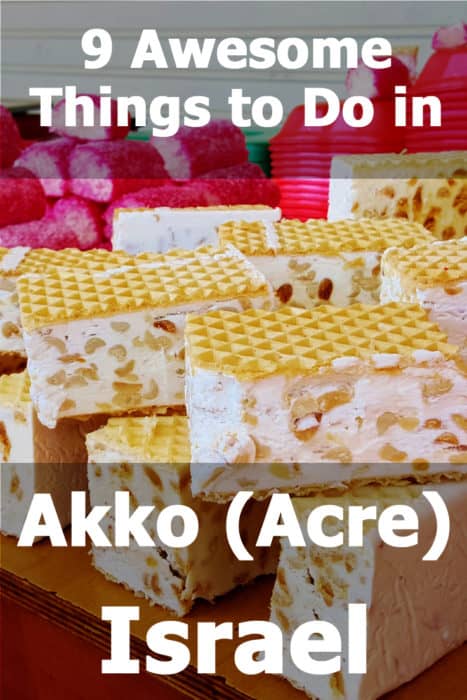
Curious but is there a place in Akko to sample and see the production of the famous Akawi cheese that supposedly originated in Akko/Akka? Maybe an artisanal cheese factory that produces it, if the ancient one that gave it fame is no longer there (I wonder what it is now)?
Hi JD, To be honest, this is my first time hearing about Akkawi cheese. There are several artisanal cheese factories here with tours, but I can’t find any that mentions Akkawi cheese. Sorry!
My husband and i will be visiting Israel in early March as part of a trip that does not include a visit to Haifa. We will be arriving a day early so were thinking of visiting Haifa on our own, and are now considering trying to see Akko. We arrive in Ben Gurion airport at 9 am on Sunday, and need to be back at the airport to meet up with our group by ~ 1 pm on Monday. Is this enough time to see both Akko and Haifa? Or is that just too much to do? If we were to try would you recommend renting a car? Or public transportation?
Hi Diane, Fortunately, Akko and Haifa are both very accessible via train. I normally am all for renting a car here but for these two cities, I actually think public transportation should be enough. The only question would be your luggage. If you’re traveling light and don’t mind taking a carry-on with you, then you can get a train from the airport all the way to Akko or Haifa on Sunday. Keep in mind that travel time is going to be 2-3 hours. You should be able to make it by noon. If you rent a car, it’s going to take you a couple of hours as well but will likely be more stressful, driving in a new country right after a flight. In theory, you should be able to tour Akko on Sunday from noon till evening time, then either board a train to Haifa or stay the night in Akko. Then in the morning, you could take a train to Haifa, do some sightseeing for a couple of hours and then take the train back to the airport. I’m using “in theory” here because I’m not sure where you’re coming from but if it happens to be from the US, then I’m not sure such a hectic couple of days are a good idea right after a transatlantic flight. For ourselves, we usually take the first day very slowly, just to get used to a place. You’ll probably be jet-lagged too. Just something to keep in mind. If I were you, I’d avoid driving these during these two days and focus on either Haifa or Akko but not try to squeeze both into the same 24 hours. Of the two, my vote would go to Akko, simply because it’s smaller and the area to tour is all walkable. With Haifa, you’ll need to plan your itinerary in the city and it might not be limited to a specific point (it’s also hilly if that’s a consideration). I hope this helps! Enjoy your time in Israel!
Hello Thanks for your help I want to visit Akko with a group this June 2020 bh A few years we went and there is some fast boats in Akko Do you know any way to contact those fast boats to make a reservation ? Thanks
Hi Joyce, I Googled this in Hebrew and found these two operators – http://www.galilsail.co.il/sailing-acre/ http://www.malkatakko.co.il/ The second site is only in Hebrew but they have this email address there – [email protected] and you can also try contacting them via their Facebook page . Good luck and enjoy your trip!
Anne I apreciatenir very very much Thank you
Thank you for the great info on Akko. I’d been to Israel years ago on a tour in the Jerusalem area. I’m thinking of going back but not on a tour. I’d like to make Akko a destination. I have one question. I’ve seen video on someone that was visiting Akko and I noticed in the background there were locals fishing from shore. Is that something that a visitor would be able to do ? I haven’t been able to find any information online.
Hi Aaron, Great question. There’s no need for a license to fish from the shore (I just checked that on the official website . The page is in Hebrew but I think Google Translate can help with that). I guess the only question is where can you rent fishing equipment. You could buy your own or bring it (I’ve never done any fishing so no idea about the quality needed). I found this fishing store in Akko with what seems to be an active Facebook page . If you’re interested, maybe you could ask them. Enjoy your visit!
Thank you very much for the info. I had tried to find some info but couldn’t so thanks for taking the time to research that. Yeah I’ll try Google translate. Thanks again and have a good day.
Great site! We are visiting Israel for 3 weeks in March 2020 and will be staying in Akko in an apartment overlooking the sea. Your information on the Old City is wonderful and the pictures are so beautiful. Thank you for the instructions! We look forward to visiting your beautiful city!
So glad this helped! I hope you have a great trip, Marilyn!
Hi, You have a great site and we are planning ahead for our Feb trip. Would you recommend a guide for a day trip to Akko coming from Haifa? If not, are there English headsets we can rent for a self guided trip on the site you mention? Do you know of any guides who would do a day trip to Safed from Haifa? Thank you.
Hi Julie, No need to take a local guide, as there are indeed headsets you can rent (I don’t think there’s an extra fee but I’m not 100% sure on that). They do have them in English as well. Having said that, if you wanted to, a private tour guide is an option as well. I’m sure there are many guides who can pick you up in Haifa and take you to the Galilee, including a tour of Safed. There’s so much to see in the region, it actually makes sense to do that if you prefer not to drive yourselves. I don’t have any specific recommendations but I found these links for you – https://www.toursbylocals.com/find_guide&area=980 https://dannythedigger.com/galilee/jewish-galilee If it’s Safed itself that you want to see – and no other places around it, then you could take a bus there from Haifa and then spend the day walking in the old town. I hope this helps and enjoy your trip!
We are planning a trip April 2019: April 1 – 10 Egypt, April 11-18 Israel, April 19-22 Jordan. My questions to you – 1. Israel is the week before Passover/Easter. Will we encounter crowds? Would it be better to reschedule the Israel portion PRIOR to Egypt? 2. The Department of Homeland Security USA is saying NO to travel in Egypt & Israel, (especially in light of the recent attacks the last few days) but Jordan is safe. I realize Gaza and the West Bank is dangerous – should this deter our plans? Why or why not? 3. We have 3 separate tour companies, one for each country. In one country we will pay $162/day for the guide. We are not confident enough to drive ourselves (although we have driven France, Portugal, Spain, Ireland, Germany, and New Zealand.) I do think we can handle a day in Haifa, Akko, Jerusalem, on our own. We would surely glean much from a guide, but is there a different and cheaper way to secure one? We have relied on the “i” in most of Europe. 4. Where in Israel would we benefit from the 3 religious viewpoints via a guide (Jewish, Muslim, Christian) besides Jerusalem? 5. If you were going to be in Israel for 6 days, where would you suggest we choose accommodation? (We will NOT be going to Dead Sea or Masada). Your blog has great information….wish I had found it 4 months ago when I started my planning!
So glad you enjoy the blog. Sorry about the delayed response here 🙂 Let’s see if I can help you out with your questions.
1. The Passover holiday this year is between April 11th and the 27th. The crowds really begin to be a problem after the holiday itself begins which is on the 20th. The first week of the school holiday, most adults still work or they’re busy spring cleaning. If you’re traveling with kids and plan on including “children attractions”, I would definitely try to switch between Egypt and Israel. Otherwise, there’s a small benefit to switching but it’s not a huge deal.
2. I don’t think you should avoid visiting Israel. As far as I can tell, they’re concerned about a sudden flare-up with Gaza but unless you’re near that area, even that should not affect your plans. Read my recent post on this very topic here: Is it safe to visit Israel .
3. This is really a matter of personal choice. I would say driving here is more challenging than driving in the US or France. Less challenging than driving in Romania. As challenging as driving in some parts of Italy. That’s based on my own personal experience. And we recently managed driving in Romania just fine 🙂
Personally, I don’t like tour groups. If you can afford to hire a guide just for yourself, that’s definitely going to help but like you said, it’s not cheap. However, if it includes the price of the car (and having someone else drive for you), it may be worth it. You’re definitely get to see and do more if you’re with a car and not public transportation. If you feel comfortable driving and it’s significantly cheaper, you should be able to swing it on your own. Sounds to me like you’re already working on a great itinerary, so I’m sure you’re reading up on the places etc.
4. Hmmm good question. Probably anywhere where the three religions “meet”. I would say places like Haifa, Jaffa and Nazareth would all be interesting in that respect.
5. Six days is not a lot. Now, if you have a car, I would do three days in the Galilee, possibly hopping over to the Golan Heights too in one of them (if current Middle East politics interest you and you want to see Syria for yourselves). Jerusalem for another two days probably (no need for a car there) and I think the sixth day, possibly Tel Aviv. There’s a whole lot more to see and do, of course. If you could afford to spend 2-3 more days in Israel, I would add the Western Galilee including Akko, Haifa and the Karmel Mountain area.
To clarify, that’s how I would divide it in terms of accommodation as well. Stay in the Galilee for 3 nights, 2 nights in Jerusalem and one in Tel Aviv.
I hope this helps! I’m sure you’ll have a great time, wherever you go!
Hi Alexis, This was such useful information. Helped me a lot. Thanks.? I just followed the list and was perfect to know Akko.
Thanks for this great resource- You’ve basically planned my day in Akko for me! One question- I’ll be traveling from Tel Aviv en route to my next destination, so I’ll have my big backpack with me. Do you happen to know if the train or bus station has lockers or any left -luggage service?
Hi Megan, I’m glad I could help! I never noticed any lockers so I called the Akko information center for you (tel. 1-700-708-020 in Israel if you want to ask them too). They said there are no lockers and travelers just go around with their backpacks 🙁 I did check the train station website as well and there was no mention of lockers on their website either. Sorry!
Wow- thank you for checking! That was so nice of you! I appreciate it!
Hi planning a trip to Akko in pesach. Are there restaurants kosher for pesach?
Hi Patricia, Any kosher restaurant in Israel will be kosher for Pesach. Most Arab restaurants won’t be but then, they’re not kosher anyway. I ran a quick Google search and these come highly recommended: Roots at Weizman St 1, Akko. Phone: 04-884-8040 YR Kibbutz fish (Degei Hakibbutzim) at 22, Gdud st. Phone: 04-999-6262
I hope this helps!
Do you have an Akko tour?
Hi Alexis, I’m not a tour guide but I’m sure many guides and companies do offer such tours. If you’re looking for a free self-guided alternative, the City of Akko has a few options listed here – http://www.akko.org.il/en/Old-akko-Walking-Tours-in-akko
I’m a mountains girl, but your picture of the Mediterranean is breathtaking.
Leave a Reply Cancel Reply
Your email address will not be published. Required fields are marked *
Name *
Email *
Add Comment *
Post Comment

12 Top-Rated Tourist Attractions in Akko (Acre)
Written by Jess Lee Updated Dec 22, 2023 We may earn a commission from affiliate links ( )
Steeped in medieval Crusader history, Akko is an atmospheric old town surrounded by lofty fortifications.
For history fans, Akko is one of the best places to visit in the country thanks to the preservation of its stone architecture. There are plentiful historic tourist attractions and things to do amid its squiggle of narrow alleyways with khans (caravanserais), fortifications, and Crusader-era monuments to explore.
Plan your visit with our list of the top-rated tourist attractions in Akko.
See also: Where to Stay in Acre
1. Fortifications
2. ahmed al-jazzar mosque, 4. crusader city, 5. khan al-umdan, 6. crusader tunnel, 7. st. john's church, 8. akko harbour, 9. hammam al-pasha museum, 10. old town souk, 11. bahje baha'i centre, 12. lohamei hagetaot, where to stay in acre for sightseeing, history of akko.
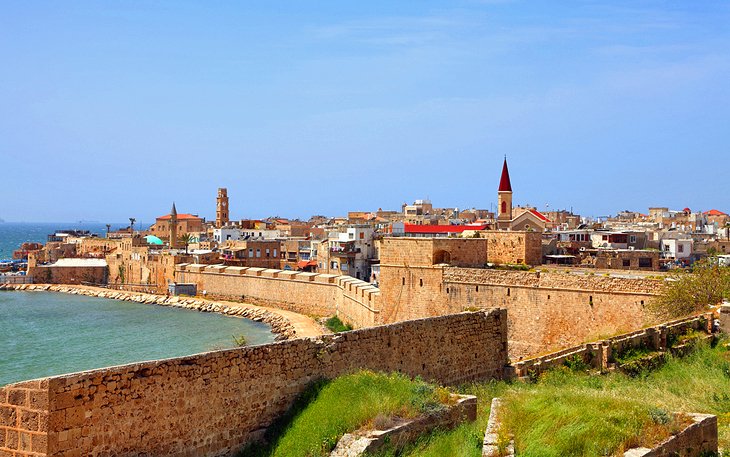
Akko's incredible surviving walls, which wrap around the old city, are the town's most distinctive feature. For panoramic skyline views across Akko, walking along these ancient defensive barriers can't be beaten.
The fortifications were given their present form by Ahmed el-Jazzar in the 18th century.
From Weizmann Street, you can climb up onto the ramparts and walk to the northeast corner, dominated by the massive tower known as the Burj el-Kummander . It stands on the foundations of the "Accursed Tower," from which Richard the Lionheart hauled down the Duke of Austria's banner in 1191.
A little further south from here, sited in the walls, is the Treasures in the Wall Museum, which has an ethnographic collection of artifacts from early Zionist settlers in the area.
If you head back east along the wall, towards the sea, you come to the Burg Kurajim (Tower of the Vine). This Ottoman bulwark, built to defend the town against sea attacks, is built on foundations dating from the Crusader period.
Address: Weizmann Street, Akko
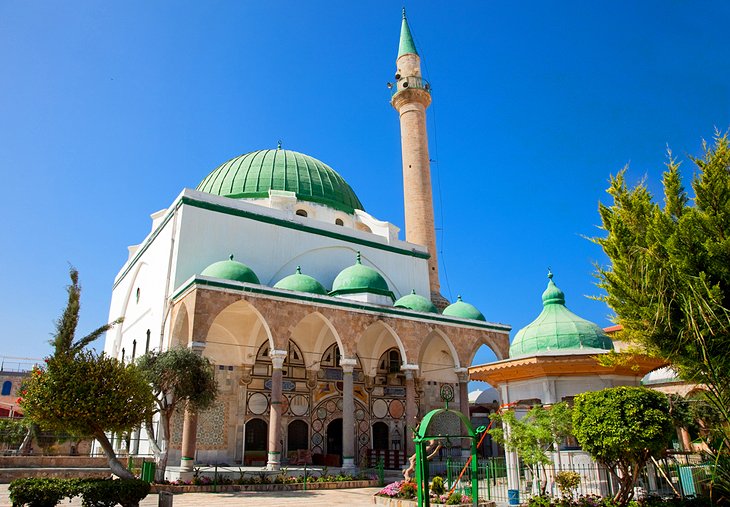
Occupying the site of the Crusader cathedral, the Ahmed Al-Jazzar Mosque was built in 1781 on the model of an Ottoman domed mosque.
The courtyard is entered by a flight of steps, on the right of which is a small Rococo-style kiosk.
Surrounding the arcaded courtyard are rooms, which once provided accommodation for pilgrims and Islamic scholars. On the east side of the arcaded gallery, steps lead down to a cistern dating from the Crusader era, which provided a water supply for Akko's population when the town was under siege.
A small, plain domed building to the right of the prayer hall entrance contains the mausoleum of Ahmed Al-Jazzar, who died in 1804, and of his successor, Suleiman Pasha.
The mosque itself, with its tall slender minaret, is a fine example of Turkish Rococo architecture, with a mammoth interior decorated in ornate blue, brown, and white.
Address: Al-Jazzar Street, Akko
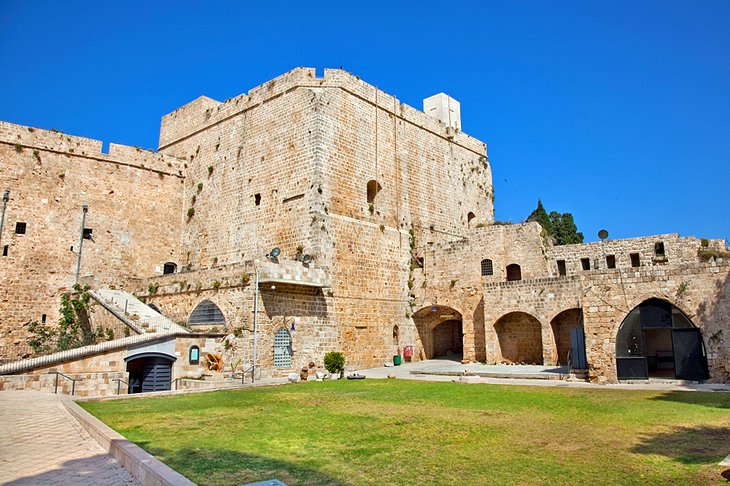
The grand bulk of Ahmed Al-Jazzar's 18th-century citadel sits just inside the old city walls and is one of Akko's major points of interest.
The current Ottoman-era building is sited atop an earlier citadel structure that was built by the Crusaders.
During the British Mandate period, the citadel building was used as a prison by the British and today, houses the Museum of Underground Prisoners .
This museum commemorates the Jewish fighters who were imprisoned or executed here by the British authorities during the Mandate era, with a collection of black and white photographs and original documents from that time.
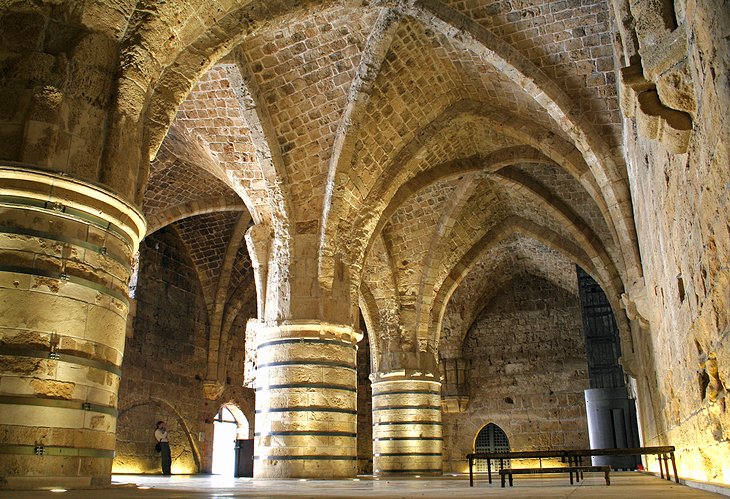
Underneath Ahmed Al-Jazzar's citadel is the highlight of a citadel visit. The Crusader City historic site comprises a fascinating series of gothic vaulted halls, which were once headquarters for the Knights Hospitaller.
There are six connected vaulted halls, as well as a dungeon to explore, with the Knights Hall and Dining Hall the best examples of the grand, soaring Gothic architecture of the medieval Crusader period.
The non-claustrophobic can navigate their way through a narrow subterranean tunnel to the crypt after they've finished visiting the halls.
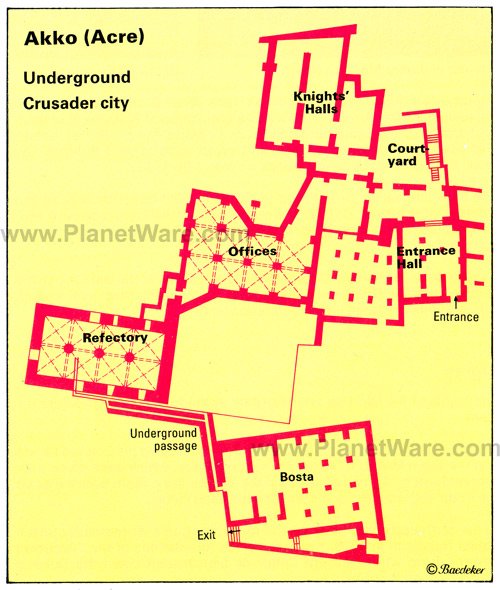
The Khan al-Umdan (Khan of the Columns) gained its name because of the granite and porphyry columns that Ahmed el-Jazzar brought from Caesarea to build this khan.
Built on the site of the Crusader's Dominican monastery, the khan provided traveling merchants with accommodation while trading in the city.
Set around a large rectangular courtyard, the ground floor rooms would have been used for storage and stables, while the upstairs would have been sleeping quarters for the merchants.
Over the north entrance is the clock tower commemorating Sultan Abdul Hamid's jubilee in 1906.
Address: Salah Bazri Street, Akko
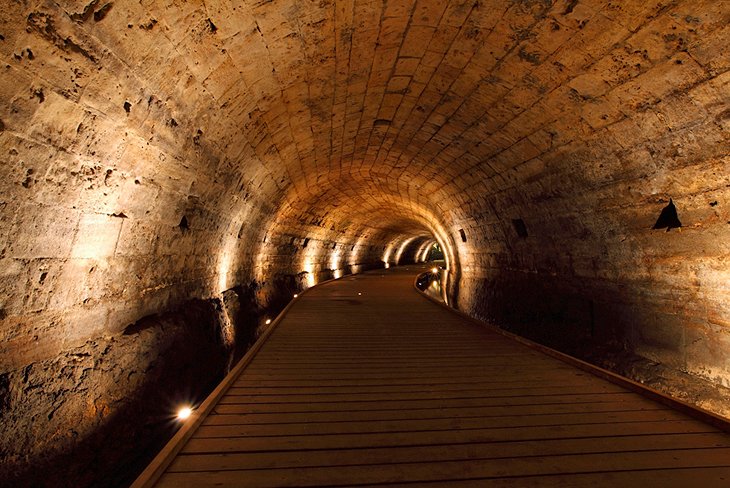
If you're not claustrophobic, this eerie Crusader Tunnel is one of Akko's most intriguing tourist attractions.
It was discovered in 1994 by a local plumber. The subterranean passage would have originally connected the harbor with a Templar palace, providing a secret escape route to the sea in case of attack.
Today, it runs from HaHagana Street to the Khan al-Umdan and provides a fascinating glimpse into Crusader architecture.
A walk through here is highly recommended if you're at all interested in the medieval Crusader history of this town.
Address: HaHagana Street
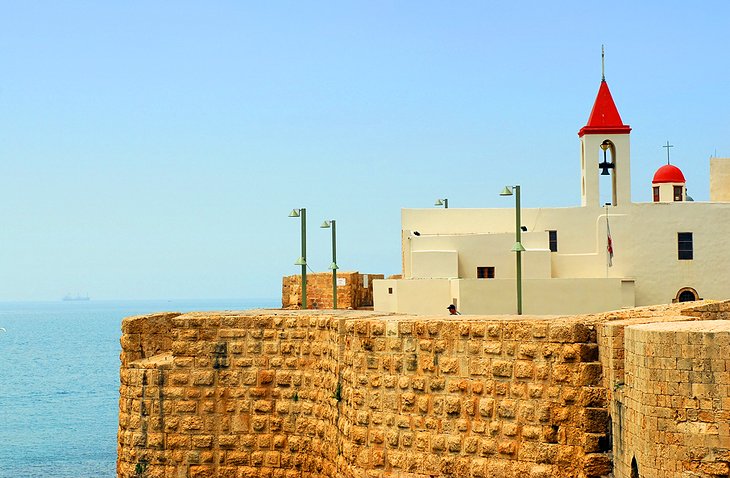
By far Akko's most picturesque church, St. John's Church was built in 1737 and occupies the site of an earlier 12th-century Crusader church dedicated to St. Andrew.
The church's interior is rather plain, and the main reason most people visit is to photograph the façade.
The juxtaposition of the church's crisp white walls and bright red bell tower surrounded by the crumbling stone walls of Akko's seafront makes this one of Akko's prettiest scenes for photographers. Come here in the late afternoon to capture the softest light.

Now home to colorful local fishing boats and yachts, Akko harbor was a busy and important port from the classical age right until the medieval period.
During the Crusader era, it could sometimes be occupied by as many as eighty ships. The original port has now silted up, and all that is left is this small, tranquil fishing harbor.
From here, you can hop on a tourist boat to head out onto the Mediterranean and get excellent views of Akko Old City from the sea.
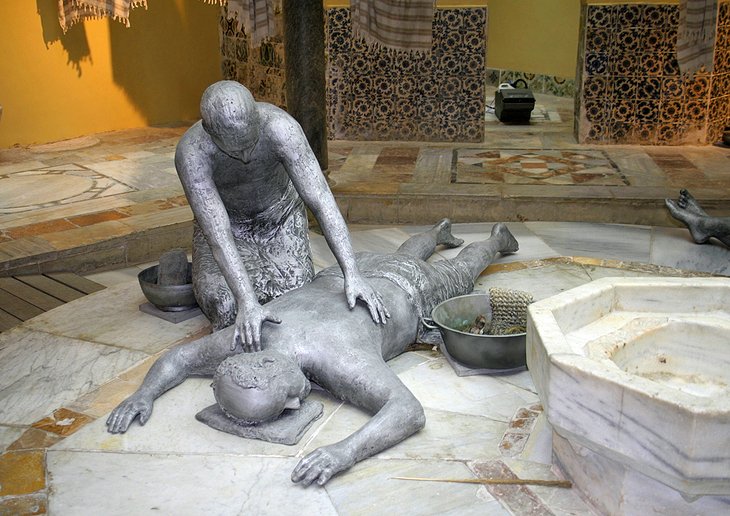
This old hammam (Turkish Bath) has been fully restored and is now home to an interesting museum with exhibits on the history and culture of the Turkish bath experience.
This hammam dates from the 18th century and is an excellent example of Ottoman-era bathhouse architecture and interior design. It was a working Turkish bath right up until the 1940s.
Visitors are walked through hammam history and traditional hammam practices with the aid of dioramas throughout the rooms, and an audio guide. The entire bathing process is explained along with the important place of hammam culture in day-to-day life.
Address: El-Jazzar Street, Akko
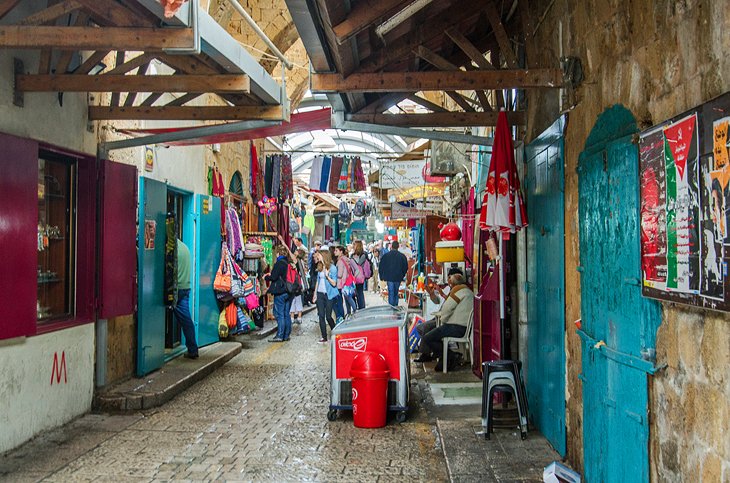
Akko's main souk (market place) is right in the center of the Old City and is a fun and vibrant bazaar full of fresh produce, cheap eats, buckets of spices, and souvenirs.
If you're looking for an original gift to bring home, it's a great place to browse for textiles and bric-a-brac, though you'll have to get your haggling hat on if you want a good price from the vendors.
If you're not shopping, strolling through this area is worthwhile simply to experience the bustle of local shoppers and take in the smells and sights of a traditional souk district.
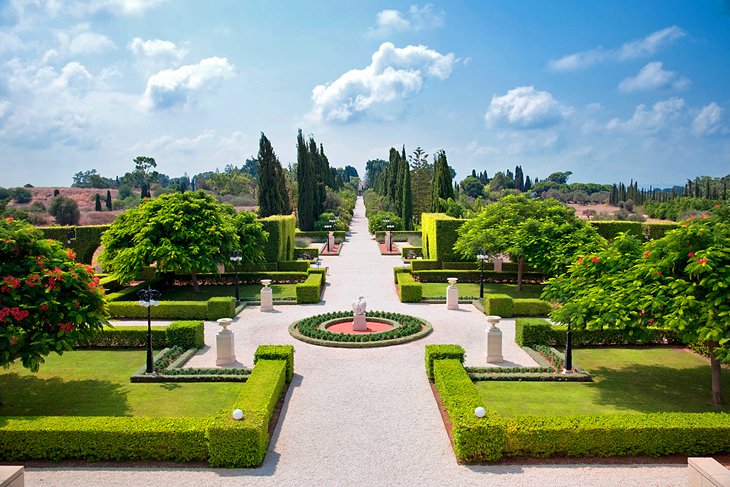
For some time out from historic sightseeing, take a trip to the beautiful gardens of Bahji , which contain the shrine of Bahá'u'lláh, founder of the Baha'i faith.
He was exiled to Akko in 1868 and spent the last years of his life in the red-roofed house in the gardens.
This is the sister site to the more famous Baha'i Gardens of Haifa . Although much smaller and more modest, Akko's garden is similarly immaculately manicured. It's also much less visited than Haifa's gardens, so it's very peaceful.
If you want to see the shrine, you have to join one of the organized tours that run in the mornings between 9am and noon. Otherwise, travelers are free to wander through sections of the gardens independently.
Location: 3 kilometers north of Akko
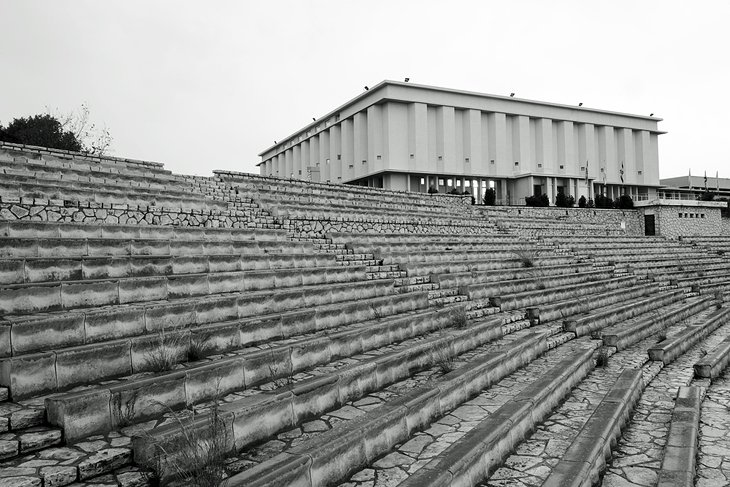
The kibbutz of Lohamei HaGetaot was founded in 1949 by Polish and Lithuanian Jews who had spent WWII fighting the Nazis.
It is home to a moving museum dedicated to the Jewish resistance and the Holocaust. On the ground floor are displays illustrating the history of Vilnius, the "Jerusalem of Lithuania," and the town's Jewish community from 1551 to 1940.
There is material on the early days of the socialist and Zionist movement at the end of the 19th century, and objects illustrating the everyday life of Polish Jews as well as an exhibit of some 2,000 drawings and paintings by concentration camp prisoners, including portraits of inmates.
We recommend these convenient hotels in Acre near top attractions like the Old City and the beach:
- Efendi Hotel : This boutique luxury property has a fantastic location and offers a rooftop lounge, beautiful views, and spa with hammam.
- Zarqa Luxury Suites : These luxury apartments provide beach views, warm hospitality, suites with kitchenettes and jacuzzis, and scenic terrace.
- Akkotel : For mid-range pricing, this family-run boutique hotel, is hard to beat. It's set in a historic building featuring stone walls and handmade furniture.
- Rimonim Palm Beach Acre : This affordable beachfront resort comes with country club access and an outdoor pool.
The history of Akko goes back to the Canaanite period. It was originally situated on Tell el-Fukhtar (two kilometers east, near the stadium), on which excavations were carried out from 1973 onwards by an international team of archaeologists.
Under Hellenistic and Persian occupation levels, remains of a Canaanite settlement were revealed, which the most recent findings suggest may have been occupied as early as 3,000 BC.
The town was conquered by Pharaohs Tuthmosis III and Ramses II, who recognized the strategic importance of its site.
From 532 BC to the Greek conquest in 332 BC, Akko was Persian. In 219 BC, it passed into the hands of the Seleucids, rulers of Syria, but was able to maintain its independence as a city-state.
Herod the Great received Octavian, the future Emperor Augustus, here and later built a gymnasium in the town. In AD 67, Vespasian used Akko, along with Caesarea, as a base for his campaign in Palestine.
The town also prospered in Byzantine times, and from the 7th century under the Umayyads, when it was the port for the Umayyad capital of Damascus.
The Crusaders were unable to take the town until 1104, five years after their conquest of Jerusalem. They renamed it St. Jean d'Acre, and it became the headquarters of the Knights of St. John.
The Italian cities of Genoa, Pisa, and Venice established trading posts in the town, and it developed into a busy and flourishing port town. In 1187, the Crusaders were compelled to surrender the town to Saladin, but it was recovered in 1191 by Richard Coeur de Lion.
After the loss of Jerusalem in 1187, Acre became capital of the Crusader kingdom, with a population estimated at 50,000.
In 1219, St. Francis of Assisi visited the town and established a nunnery. In 1228, the Emperor Frederick II landed here during his Crusade, as did Louis IX of France in 1250, after his unsuccessful campaign against Damietta. Soon afterwards, there was a bitter conflict, almost amounting to civil war, between the two religious orders, the Knights Hospitallers of St. John and the Templars.
In 1290, the Crusaders slaughtered large numbers of Muslims. When the Mameluke Sultan El-Ashraf Khalil captured the town in the following year, he took his revenge, and the Crusader kingdom came to a bloody end after an existence of just under 200 years.
After the destruction of the town, it remained uninhabited for more than 200 years, until its rebuilding by the Druze emir Fakhr ed-Din in the 17th century.
Around 1750, it was enlarged by Daher el-Amr, and this process was continued by his murderer and successor Ahmed el-Jazzar (the "Butcher"), a native of Bosnia, who ruled as Pasha from 1775 to 1805. In 1799, with British help, he withstood a siege of the town by Napoleon.
From 1833 to 1840, Akko was held by Ibrahim Pasha, who defeated the Turks in Palestine with his Egyptian forces but was compelled by the European powers to withdraw.
In the latter part of the 19th century, Akko lost its importance as a port to Beirut and then Haifa. When British forces captured the town from the Turks in 1918, it had a population of 8,000, most of them Arabs.
In 1920 and again during the Second World War, the British authorities used the Citadel as a prison for Jewish underground fighters. The town was occupied by Israeli troops on May 17th, 1948.
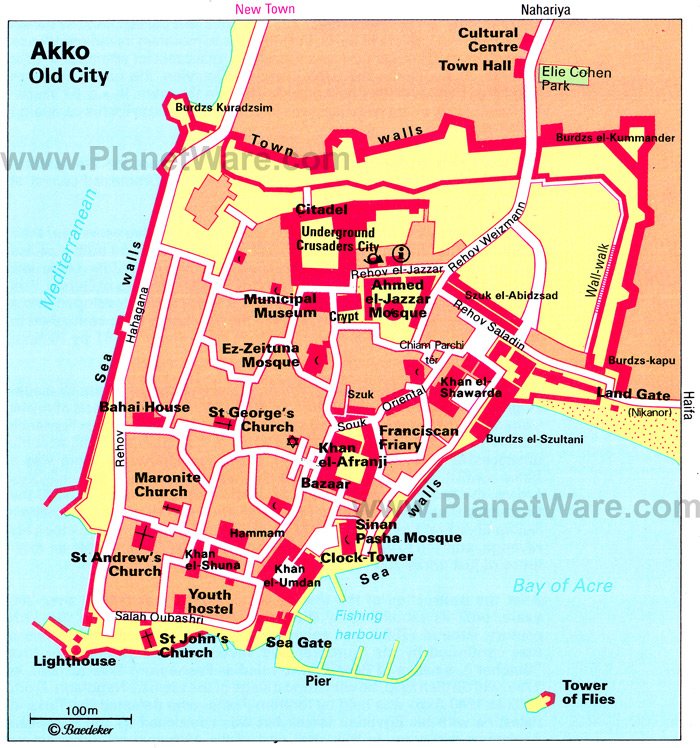
More on Israel
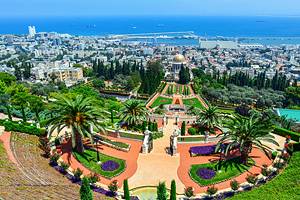

Akko (Acre) – Visitor Guide with Photos
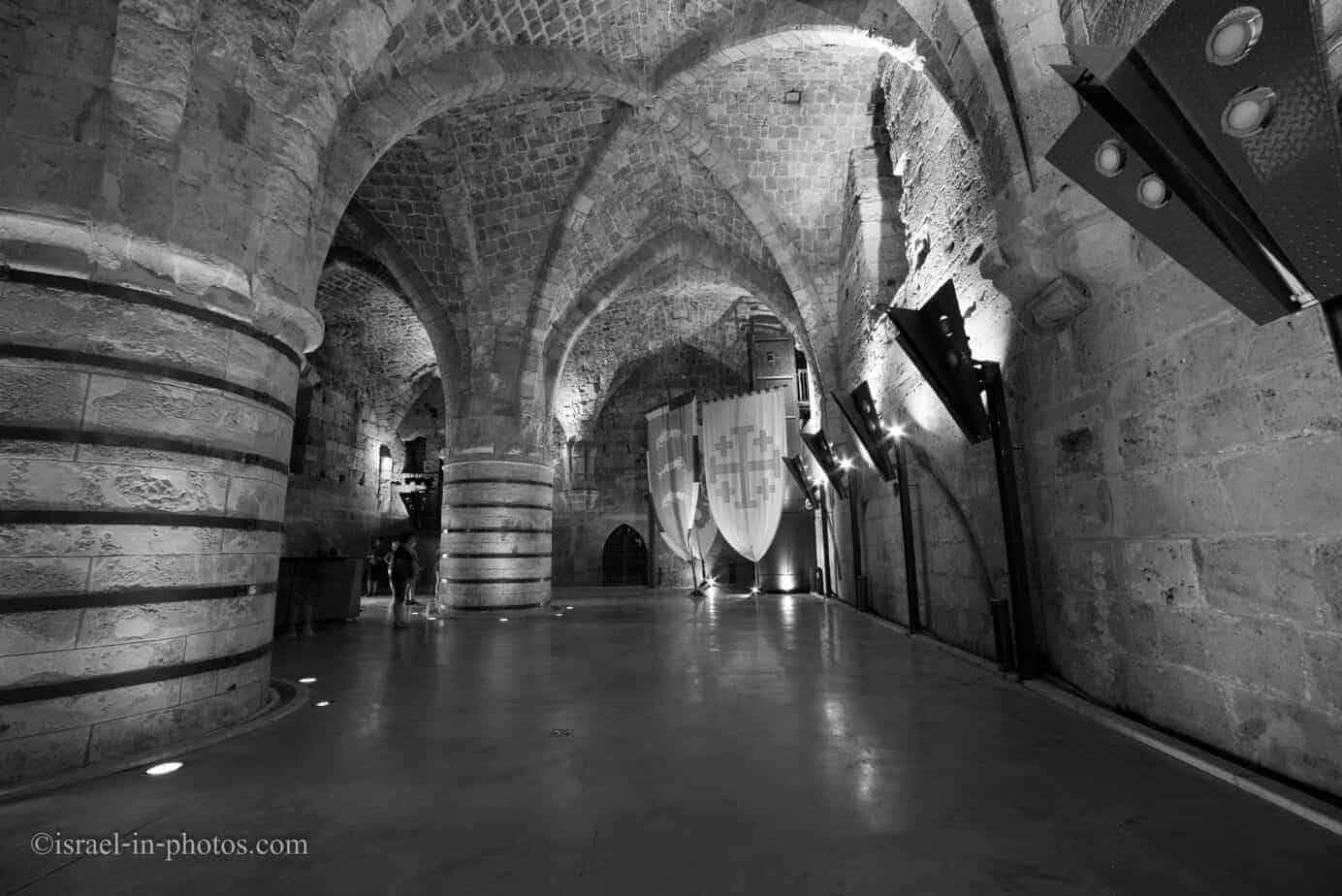
Acre (Akko) is a port city in northern Israel. It is one of the world`s oldest cities, with a rich history and many historic structures.
Table of Contents
- 1 Basic Info
- 2 Acre Names
- 3 What Does Akko Mean?
- 4 Acre and Napoleon
- 5 UNESCO World Heritage List
- 7 Old Acre Development Company
- 8 Opening Hours
- 9 Entrance Fee
- 12.1 Public Transport
- 12.2 Parking
- 13.1 The White Market
- 13.2 Hospitaller Fortress (Knights Halls)
- 13.3 Al-Jazzar Mosque
- 13.4 Okashi Art Museum
- 13.5 Hamam al-Basha – Turkish Bath
- 13.6 Templars Tunnel
- 13.7 Lighthouse
- 13.8 Saint John’s Church
- 13.9 Khan al-Umdan – Khan of the Pillars
- 13.10 Acre Port
- 13.11 Akko Market
- 13.12 Treasures In The Walls Museum
- 14.1 Bahai Gardens in Akko
- 14.2 Akko Beach
- 14.3.1 Napoleon at Acre
- 15 Attractions Near Akko (Acre)
- 16 Walking Routes
- 17 Where To Stay
- 18 Common Questions
Acre is a historic city in Northern Israel. It is located on the edge of Haifa Bay (on the coast of the Mediterranean Sea). Both land routes and sea paths (Acre has a natural harbor) made Acre a commercial standpoint. And it is one of the oldest cities in the world, continuously inhabited since the Middle Bronze Age (around 4,000 years ago).
Acre and Akko, Ace, Ptolemais, Antioch, Germanicia in Ptolemais, Colonia Ptolemais – all these names refer to the same city. But today, Akko and Acre are the ones that are commonly used.
Locals use the name Akko. Moreover, most road signs (except touristic ones) will say Akko. I guess this name is used since it was used in the Bible. Judges 1:31:
Nor did Asher drive out those living in Akko or Sidon or Ahlab or Akzib or Helbah or Aphek or Rehob.
After the Crusaders` conquest in 1104, the city was renamed Saint John of Acre (or shortly Acre), after the Knights Hospitaller, who had their headquarters there.
During this post, I will refer to the city as Acre and Akko.
What Does Akko Mean?
The short answer is that we do not know. And here is the elaborated answer:
The source of its name is unknown, however presumably, it is not Semitic. The Egyptians were using it as long ago as the second millennium BCE. But since hieroglyphics only have two consonants, the name was written as CK. There is no way of knowing how it was pronounced (the last syllable in particular). In the letters of El-Amrana, which were written in Acadian, the letter H is used to signify the guttural Hebrew letters alef-hey-chet-ayin; accordingly, the name of the city could be written either as Haca or Aca. Had the name not been preserved, we would not have been able to associate it with the name appearing in the hieroglyphics clearly. The AKK spelling was preserved in the Assyrian language. Ancient Hebrew legend has it that the Mediterranean Sea flooded the world, and when it reached the shore of Akko, it stopped short. As written in the Book of Job (38:11), “Hitherto shalt thou come, but no further.” In the legend, the Hebrew words “Ad Po” [hitherto] become “Ad ko” – hence, Akko [Akko].
Note: unless stated otherwise, all quotes were taken from the official site .
Acre and Napoleon
You will see references to Napoleon Bonaparte in many places around the city. And for example, in the movie at Turkish Bath – Hamam al-Basha, one of the characters mentions how they defeated Napoleon. And indeed, Acre is one of the few cities that withstood Napoleon’s siege.
After the siege and capture of Jaffa in 1799, Napoleon attacked Acre.
The Siege of Acre of 1799 was an unsuccessful French siege of the Ottoman-defended, walled city of Acre and was the turning point of Napoleon’s invasion of Egypt and Syria. It was Napoleon’s first strategic defeat as three years previously he had been tactically defeated at the Second Battle of Bassano.
Source: Wikipedia
UNESCO World Heritage List
The Old City of Acre was added to the UNESCO World Heritage List under the following criteria:
- Acre is an exceptional historic town that preserves the substantial remains of its medieval Crusader buildings beneath the Muslim fortified town dating from the 18th and 19th centuries.
- The remains of the Crusader town of Acre, above and below the present-day street level, provide an exceptional picture of the layout and structures of the capital of the medieval Crusader Kingdom of Jerusalem.
- Present-day Acre is an important example of an Ottoman-walled town. It has typical urban components such as the citadel, mosques, khans, and baths well preserved, partly built on top of the underlying Crusader structures.
Source: UNESCO
Before starting the visit, I just wanted to mention that Acre is a tourist destination. And many firms offer tours either only to the town or combined with other nearby attractions, like Haifa and Rosh HaNikra Grottoes . Therefore, if you love joining tours, see the Bein Harim offer above.
Old Acre Development Company
Most touristic sites in the city belong to Old Acre Development Company ( official site ). That allows them to sell combined tickets to various attractions in the city and outside.
The sites under their management are Hospitaller Fortress , Okashi Art Museum, Turkish Bath, Templar Tunnel , Visitors Center (near the Hospitaller Fortress ) , Treasures In The Walls Museum , and Ramchal Synagogue.
Opening Hours
Sites managed by Old Acre Development Company are open seven days a week. Sunday – Thursday and Saturday: 9:00 – 18:00 (till 17:00 in winter). Friday and holiday eve: 9:00 – 16:00
- Winter time is November – March.
- Ramchal Synagogue is closed on Saturdays and holidays.
Entrance Fee
The basic combined ticket includes Hospitaller Fortress , Turkish Bath, The Okashi Museum, Templar Tunnel , the Treasures in the Walls Museum , and Ramchal Synagogue. It costs 49 NIS per person. On top of the basic combination, you can add additional sites like Rosh Hanikra , Haypark zoo , and others. So there is a variety of combo tickets.
Note: opening hours and ticket prices were updated in January 2023. In any case, recheck the official site before visiting.
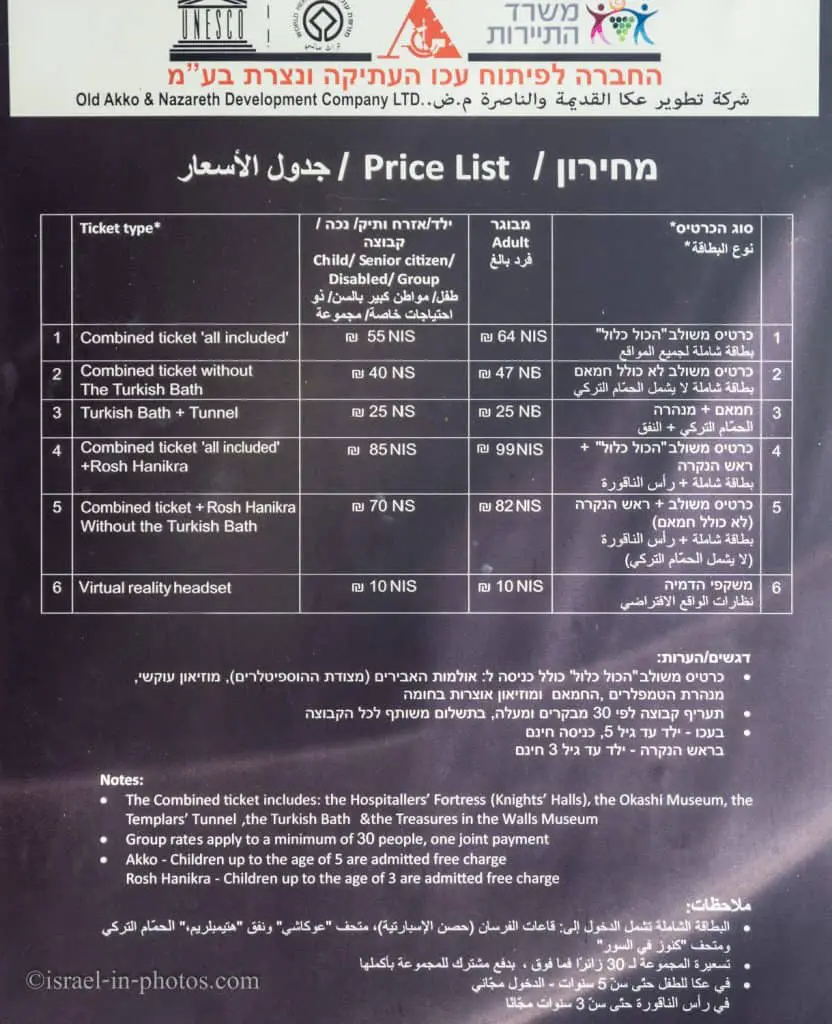
I revisited Akko in August 2019 and used this coupon for that visit . It allows purchasing the basic combined ticket with and without the Turkish Bath at a 15% and 18% discount, respectively. I bought it through their site and received an SMS and an email with an order number. Then I told this number to the cashier at Hospitaller Fortress and received the tickets. Moreover, since coupon processing is fast, you can probably purchase through it on-site (but keep in mind there is a delay risk).
Old Acre is the old part of the modern city of Acre. Furthermore, most of the tourist attractions are located within Old Acre. And most of this post will be dedicated to this small part of the city, where most attractions can be reached within a 5-minute walk.
Directions for drivers: Link to Waze and Link to Google Maps Directions for public transport: Link to Moovit
Interactive map of the area:
- Hotels, hostels, and apartments in this area:
- Buy photos of Israel and support this blog.
- Get 10% off for your next tour at Bein Harim with coupon code LEV10#12306.
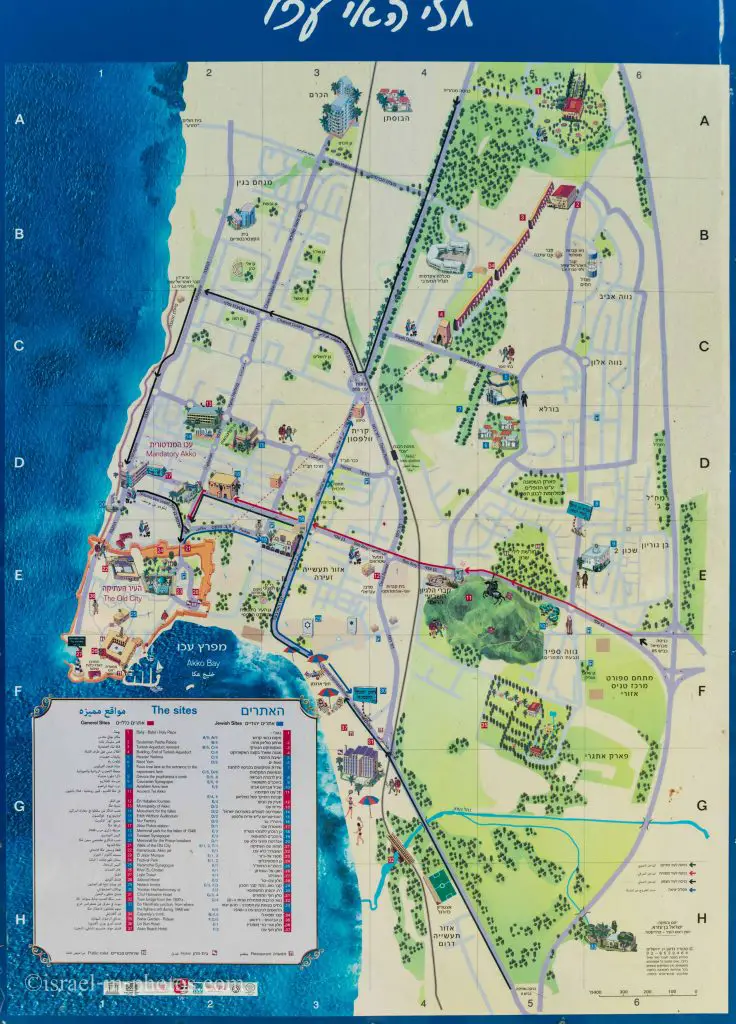
- The first map shows the city (the Old City is in the bottom left corner). And the second map shows a closeup of the Old City of Acre.
- As you can see from the first map’s scale, the size of the Old City is about 700 by 600 meters.
- You can click on the maps to enlarge them.
- You can also find a helpful map here .
Most attractions are located within the Old City. Thus the directions mentioned below are suited for those reaching the Old City of Akko.
Public Transport
Reaching Akko can be done in several ways. You can take the train to Akko station and walk from there. You can sail from Haifa (see Sails section below) or take a bus. Here is a link to Moovit with directions from Tel Aviv to Acre. You can change the starting point and get updated directions.
You can also reach the city by car. I always park outside the old town, in the new part of Acre. And I do not recommend entering the old city by car. The closer you get to the main attractions, the fewer parking spots (this is also true for paid parking). And I do not mind a five-minute walk. But if you want a closer parking lot, you can continue driving to the Land Gate, and just before the gate to the right, there is a paid parking lot.
I usually park not far from the Tunisian Synagogue (Eliezer Kaplan street 20, Acre) and walk toward the Land Gate. Before entering the gate, you will see the sea to your left. And if you continue in that direction for twenty meters, you will see Acre Port and its walls.
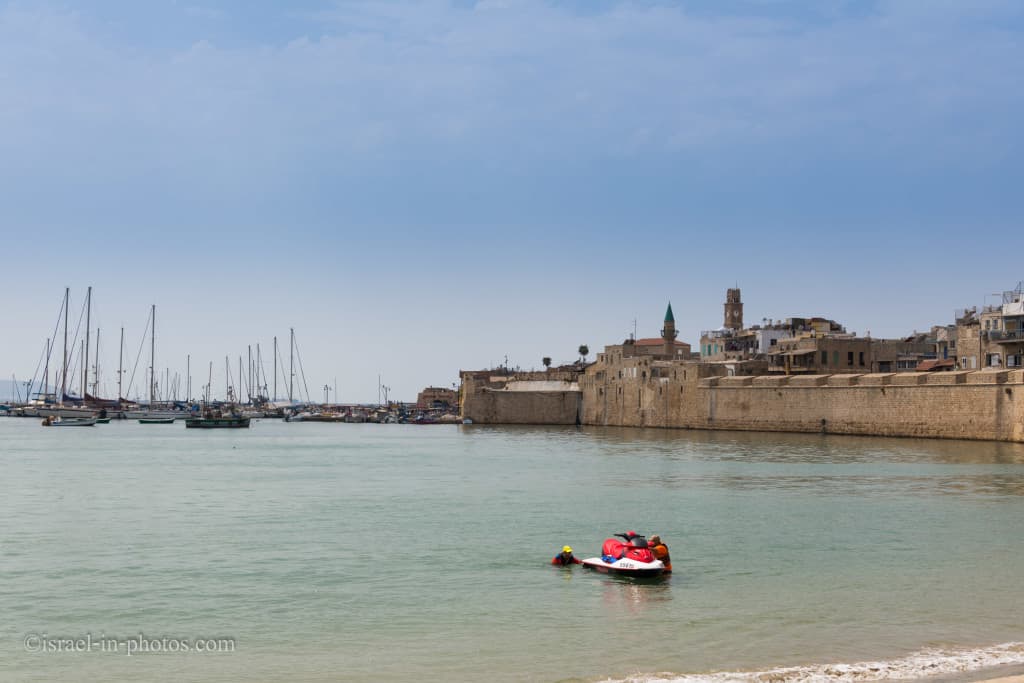
Attractions in the Old City of Akko
We will start by going through the attractions in the old city. And then check what is located further away.
The White Market
About 200m meters after you pass through the Land Gate, you can see The White Market on the right side:

The market’s walls and its sixty-four shops were whitewashed at the time they were built, hence the market’s name. The White Market is also filled with light, and perhaps that is why the attribute is often used by Acre’s inhabitants to this very day.
Unfortunately, today, the White Market is not that attractive. There are some restaurants, shops, and storage rooms. So, it lost its original charm, and the only thing worth looking at is the roof, which I showed above.
From the white market, we will head to our first stop, the Hospitaller Fortress.
Hospitaller Fortress (Knights Halls)
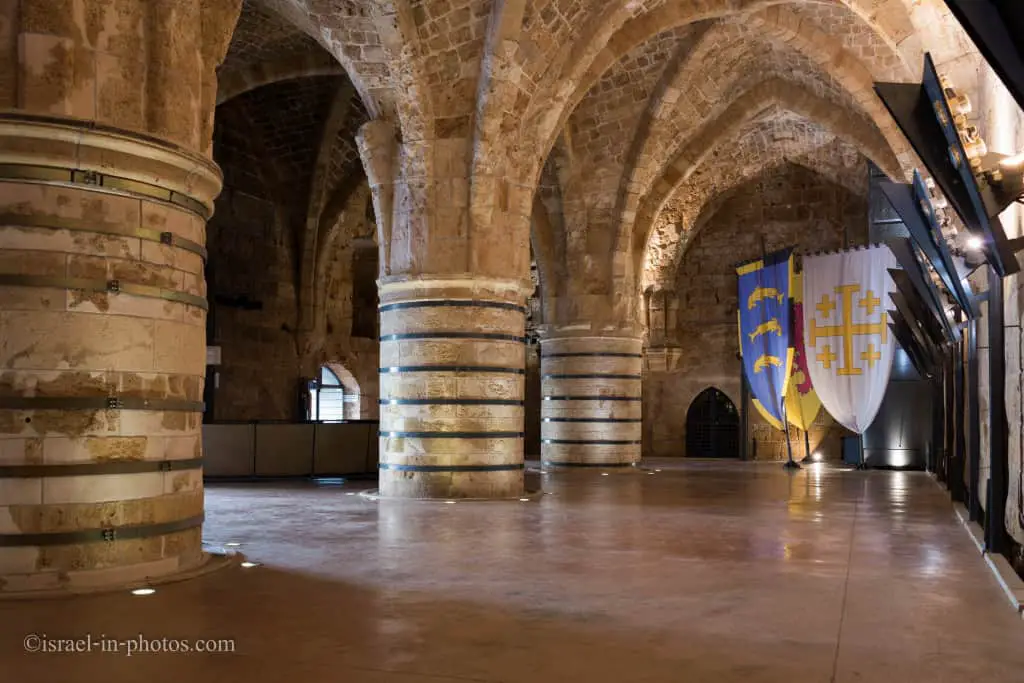
If you are reaching Akko, you probably want to visit this site. Moreover, Hospitaller Fortress (Knights Halls) is one of the reasons Acre made it to the UNESCO World Heritage List. Therefore, I would consider it a must-stop.
Note: Hospitaller Fortress (Knights Halls) is marked as #21 and #48 on the old city map.
Al-Jazzar Mosque
After a short walk from the Hospitaller Fortress, you can reach the Al-Jazzar Mosque , also known as the White Mosque.
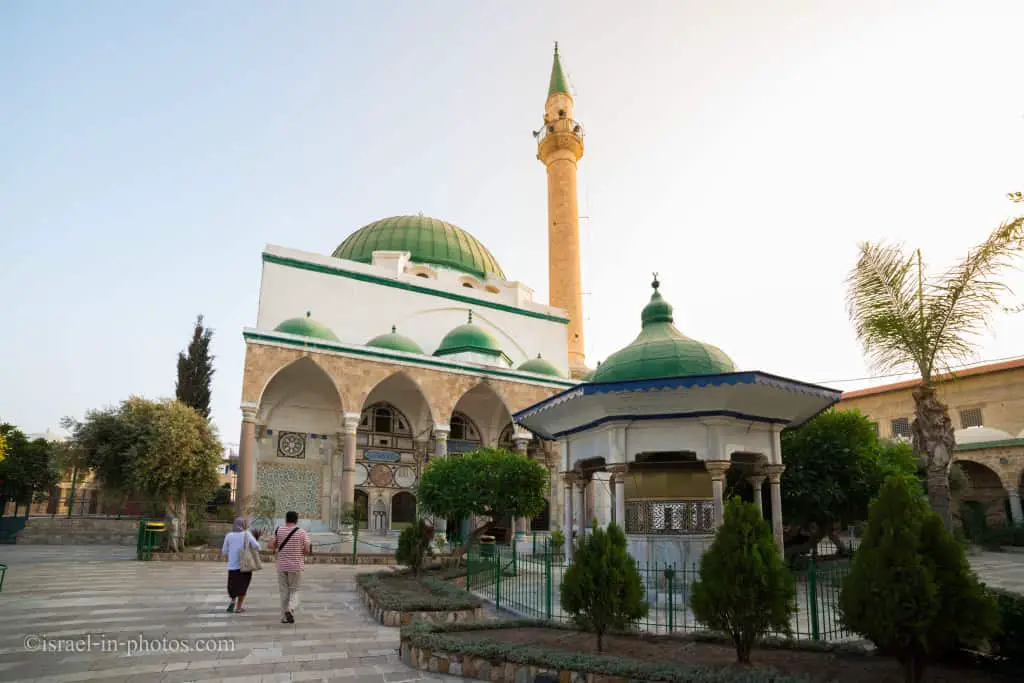
It is the largest mosque in Israel outside of Jerusalem. And it also contains an interesting relic. You can find additional information at Al-Jazzar Mosque .
And since we were at Al-Jazzar Mosque, I want to mention two nearby places: Okashi Art Museum and Hamam al-Basha.
Note: Al-Jazzar Mosque is marked as #31 on the Akko old city map.
Okashi Art Museum
The entrance to Okashi Art Museum is located about 20 meters from the entrance to the Al-Jazzar Mosque . Okashi Art Museum is a small gallery, and due to its size, it can show the works of only several artists. I visited it twice, and on both occasions, it showed modern-style paintings.
If the entrance to Okashi Art Museum were not included in the combined ticket, I probably would not visit it, but since the display is changing, it is hard to know what to expect in advance.
Hamam al-Basha – Turkish Bath
Also, not far from the Al-Jazzar Mosque , you can find the Turkish Bath.

Note: Hamam al-Basha is marked as #20 on the Acre old city map.
“Hamam al-Basha” was built at the end of the 18th century by Governor of Acre, Jazzar Pasha. At first, it was called “Hama al-Jadid” (the new Hamam), but its name was subsequently changed to Hamam al-Basha (the Pasha’s Hamam), in honor of el-Jazzar. The Turkish bath’s construction was part of Acre’s transformation during the Ottoman Period from a small fishing village (primarily at the hands of al-Jazzar Pasha) into a teeming port city and a significant construction and trade center. During his reign, el-Jazzar strove to further the town in many and varied ways. Among his accomplishments is the aqueduct, which led the well water to the city. And the breakwater for safe docking at the port. Plus major buildings such as the Khan el-Umdan – Acre’s largest mosque – his luxurious palace and, of course, the Turkish bath.
The Turkish Bath compound consists of only several halls. There is the summer dressing room, four intermediary rooms, and a hot room. In those chambers, you will learn about the history of this place and the people that lived here, and you will also see a short movie. The whole visit will take about an hour.

And now, through the alleys of Old Acre, let’s head to The Templar Tunnel .
Here we are passing next to El-Zeituna Mosque:

Templars Tunnel
A 350-meter-long tunnel connected the Templars fortress and the Acre Port . And today you can walk there. See additional info at Templars Tunnel .
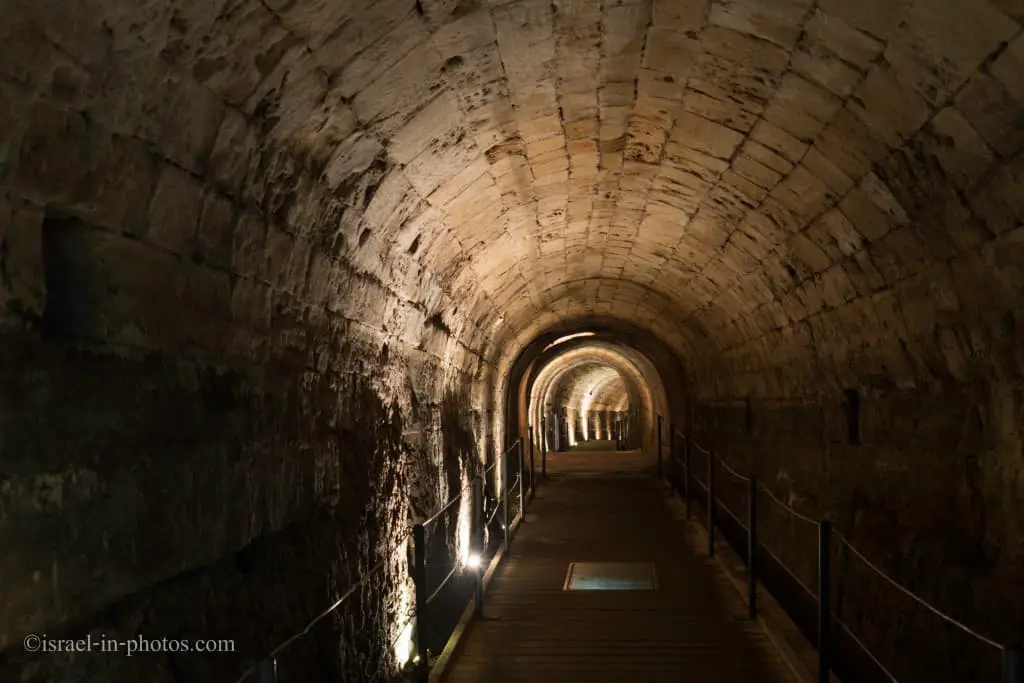
One of the exits from the tunnel is next to the lighthouse. The lighthouse is where the Templars’ fortress used to stand. Here is the lighthouse during windy weather.
Note: the lighthouse is marked as #41 on the old city map.

Not far from the tower, there is usually this picturesque juice stand.
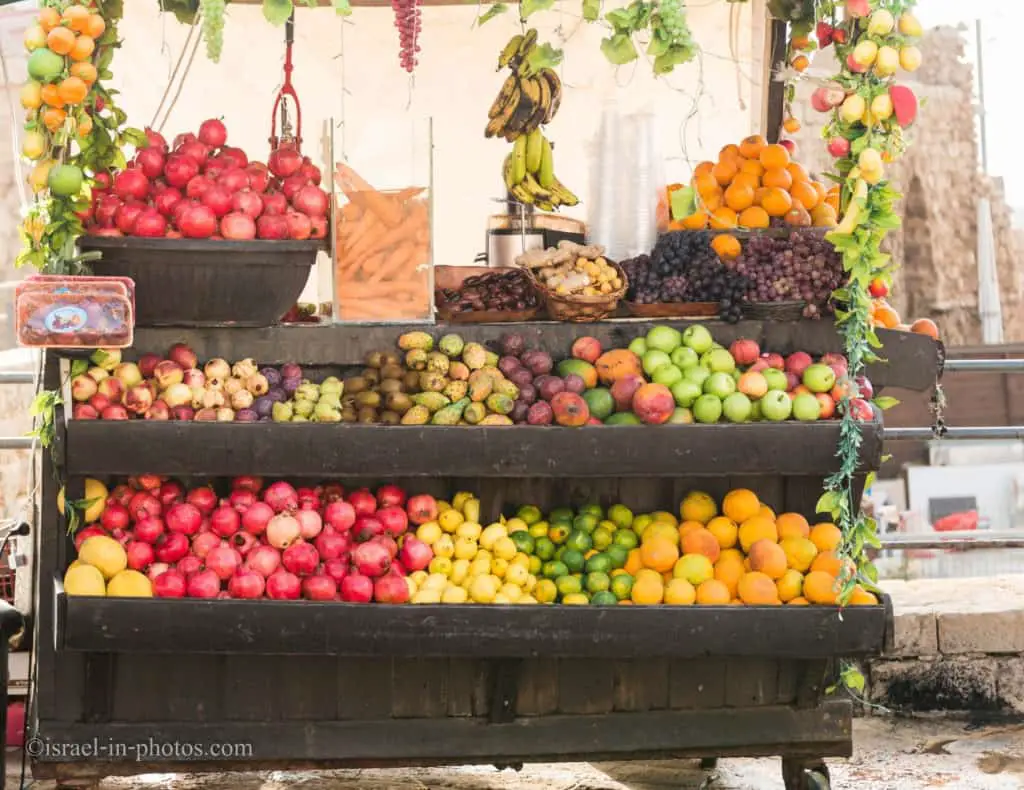
Saint John’s Church
A short walk along the old city Acre wall will lead us to Saint John Church.
Note: Saint John’s Church is marked as #26 on the Acre’s old city map.

Saint John’s Church, which currently stands next to Acre’s lighthouse, belongs to the Latin community (the Franciscans). It is unclear as to when the church was built, although several years ago, the year 1737 was found engraved in the northern wall of the building. The church was renovated in 1947 and now serves as the only church of Acre’s Latin-Catholic community.
Source: official website
On the warmer days, teenagers jump from the Old Acre walls into the sea:
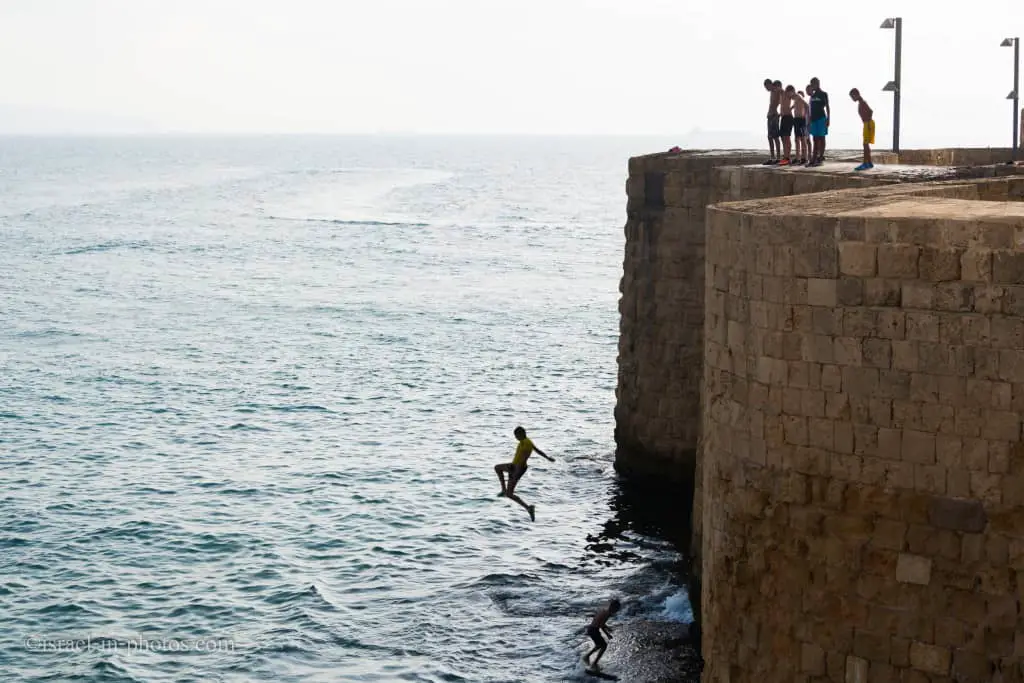
Their favorite spot is next to Saint John Church since there are stairs on the outer side of the barrier there:
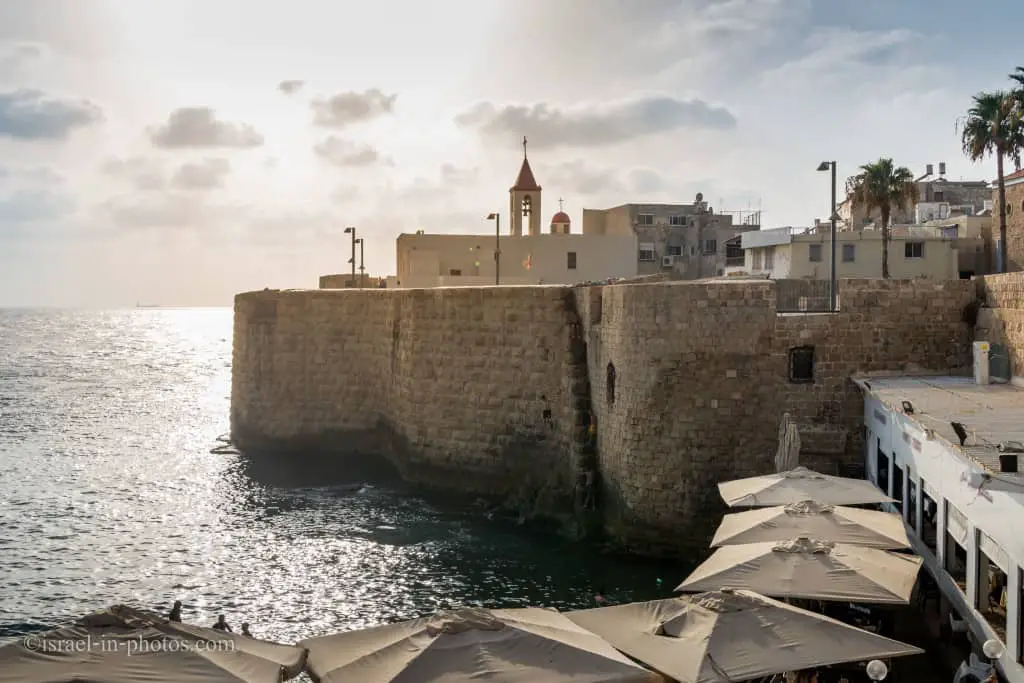
Khan al-Umdan – Khan of the Pillars
We almost returned to the point where we entered the Templar Tunnel . And near it, you can find Khan al-Umdan, also known as Khan of the Pillars.
Khan al-Umdan is the largest and best-preserved khan in Israel. And if you look at the clock tower, you can see that the clock was restored. But they did more than repair it. Now each side depicts numbers differently. Beyond the regular watch, you can also see Arabic numerals (in the following photograph) and Hebrew numbers.
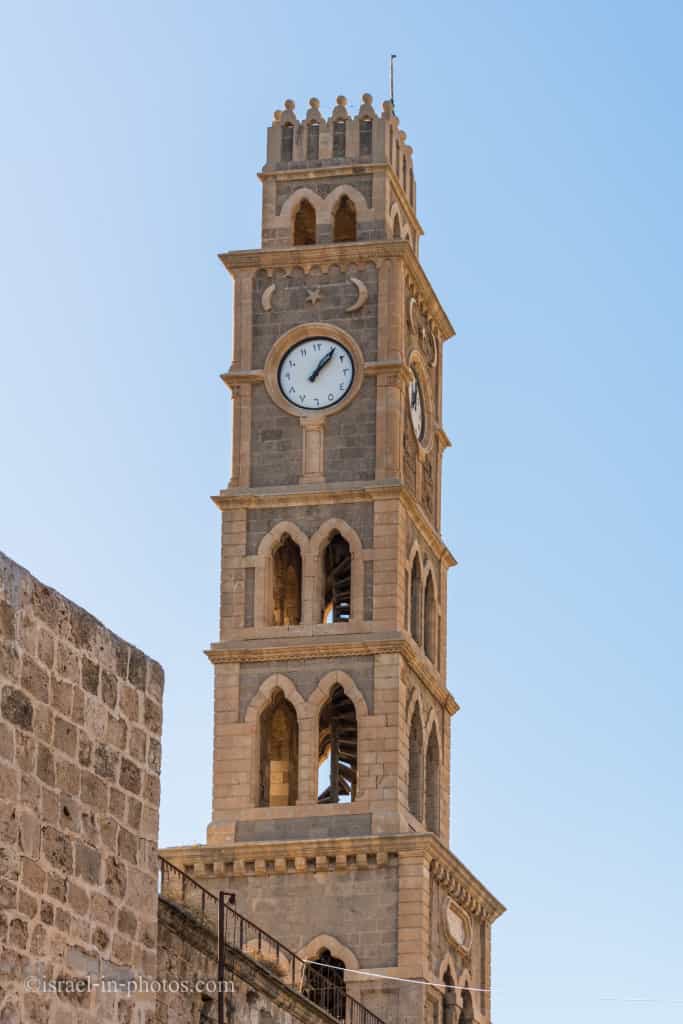
Khan al-Umdan is a large merchant’s inn adjacent to the port, which was used for international trade. Merchants who arrived at the port unloaded their goods in the inn’s storerooms on the first floor and slept in the second-floor rooms, which constituted a unique hotel. The khan was built in the late 18th century by Ahmed al-Jazzar, and it rests on a row of granite pillars brought from various sites in the area. The khan’s courtyard is open to visitors all day long.
We wanted to visit Khan of the Pillars, but unfortunately, it was closed. For years it was abandoned. And there were some lawsuits regarding converting it to a hotel. Maybe they closed it for restoration or to build a hotel inside it.
I took a photo of Khan al-Umdan’s interior back in 2014.
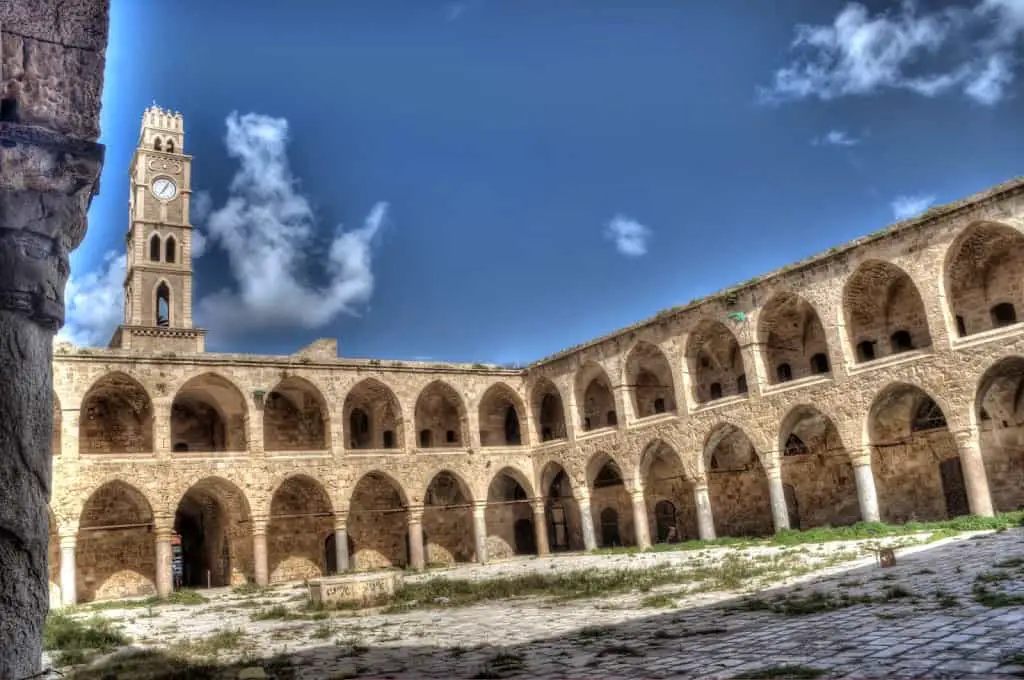
Note: Khan al-Umdan is marked as #10 on the Acre’s old city map.
And since we already mentioned the port, let’s head there.
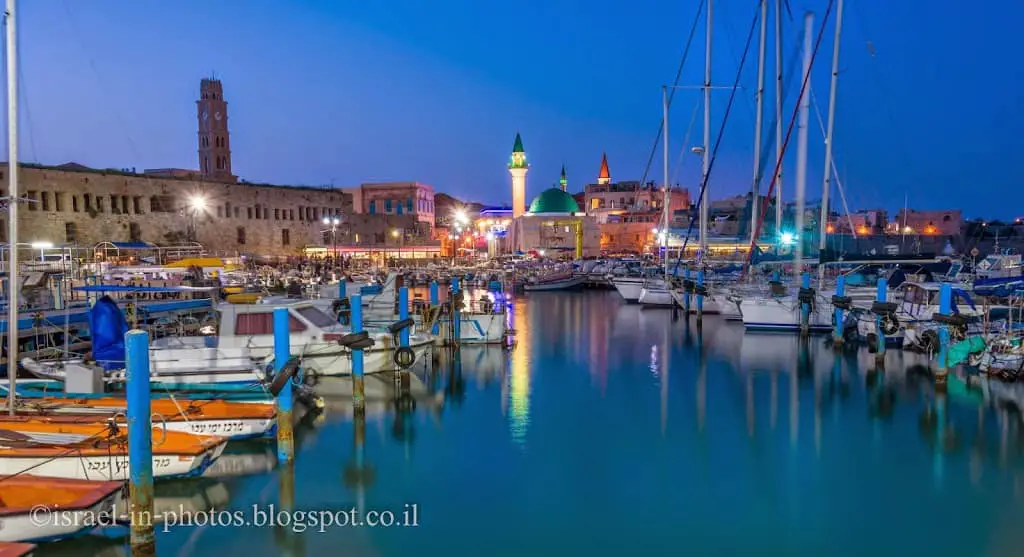
Note: Acre Port is marked as #45 on the old city map at the beginning of this guide.
At the guide to Acre Port , we will talk about history, sails, and Haifa – Akko ferry. So head on there for additional info.
Akko Market
The market is located in the old city, close to Acre Port and Al-Jazzar Mosque . You can walk towards Benjamin of Tudela street and see it.
It is not a big market, and you can pass it within 10 – 15 minutes. Though I love markets, and there is a variety of good markets in Israel, the Acre market lost its authenticity. The main reason is that many stands offer cheap Chinese goods. One of the only original things that remain in this market is food.
You can find fresh fish and traditional sweets. And if you are hungry, you can check out Hummus Said. It is a small hummus place that looks like a simple dining room and offers simple yet tasty dishes. It is located in the marketplace, and the opening hours are Sunday to Friday from 6:00 till they run out of hummus, typically 14:30.
And now, from the market, let’s head back toward the land gate (the gate we entered Old Acre through). We went there since it is near the Treasures In The Walls Museum .
Treasures In The Walls Museum
It is a lovely small Ethnographic museum. And you can read my guide to see additional info.
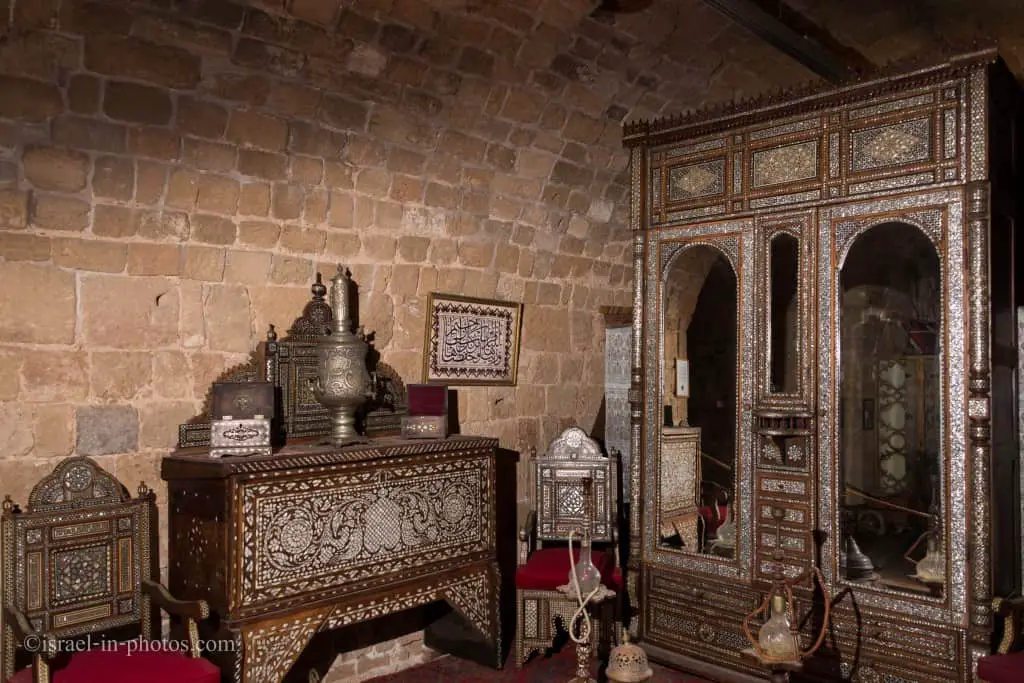
Note: Treasures In The Walls Museum is marked as #4 on the old city map.
Attractions in Modern Akko
So far, we have covered the Old City. And now, let’s look at additional sites outside of Old Acre. And let’s start with one of the most popular sites in the city.
Bahai Gardens in Akko
Bahaullah, the Prophet-Founder of the Bahai faith, resided at a mansion in Akko during his final years. His remains were laid to rest at a shrine, and today there is a big garden surrounding the area.
You can find my complete guide at Bahai Gardens in Acre .
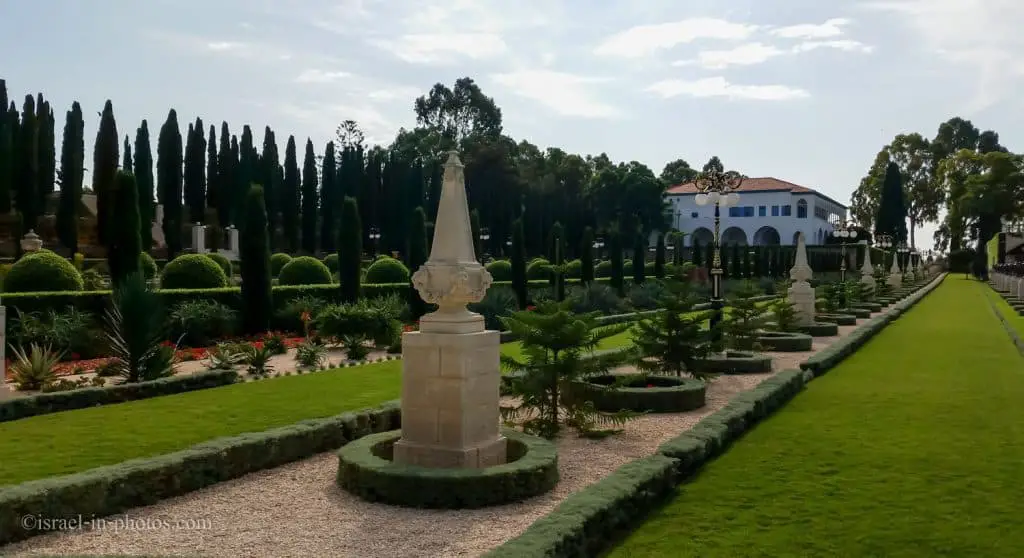
Both Bahai Gardens in Haifa and Bahai Gardens in Acre (Akko) are stunning. But most people visit the ones in Haifa . You can check both of my guides and decide for yourself.
Note: the Bahai Gardens in Acre are marked as #1 on the Acre map.
In the southern part of Akko, you can find a lovely short beach strip. You can easily spend half a day at these sandy beaches, which provide a nice view of old Acre. For additional information, check out Akko Beach (Argaman Beach) .
Note: Akko Beach is marked as #37 on the Acre map.
Napoleon Hill – Tel Akko
On another occasion, we visited Napoleon Hill, also known as Tel Akko (marked as #11 on the Acre map). Tel Akko is located on a hill in the eastern part of the city near road #85. The Tel’s height is thirty meters, and it is pretty small, 600 meters on 350 meters at the widest part.
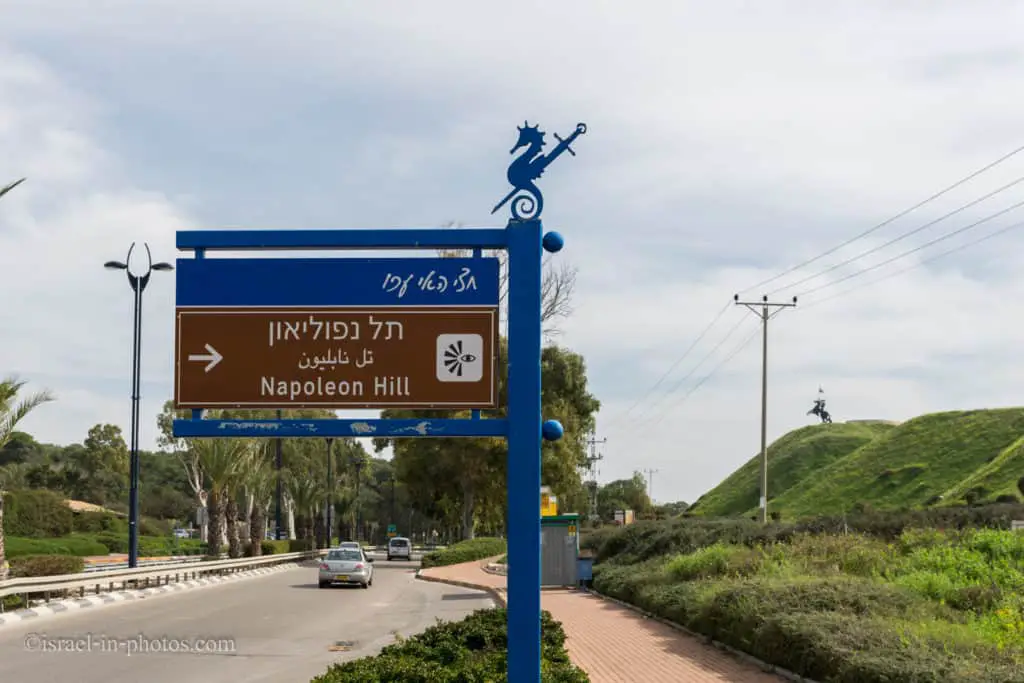
The hill has many flowers during the spring, making the walk enjoyable.
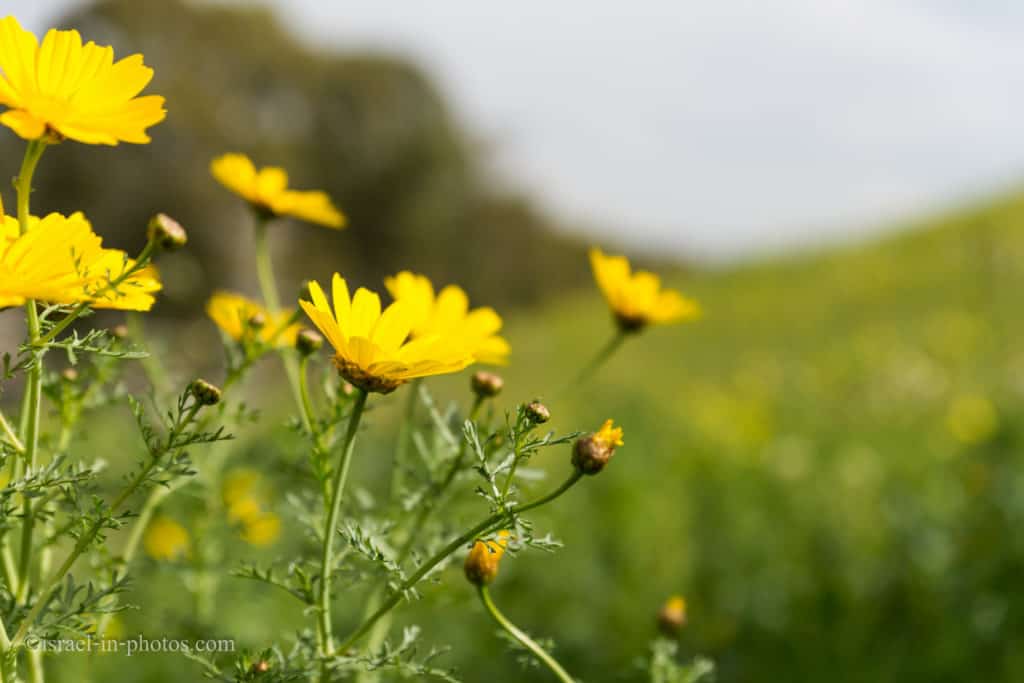
Here is a view from the hill towards the city center. On the left, you can see part of a soccer stadium with parking nearby (there are two trucks there). We parked our car there and used the stairs on the right to climb the hill.

In 2009, the touristic project of Tel Akko was introduced. In that project, paved roads for pedestrians and cyclists were created. And watchpoints, like the following one, were installed.
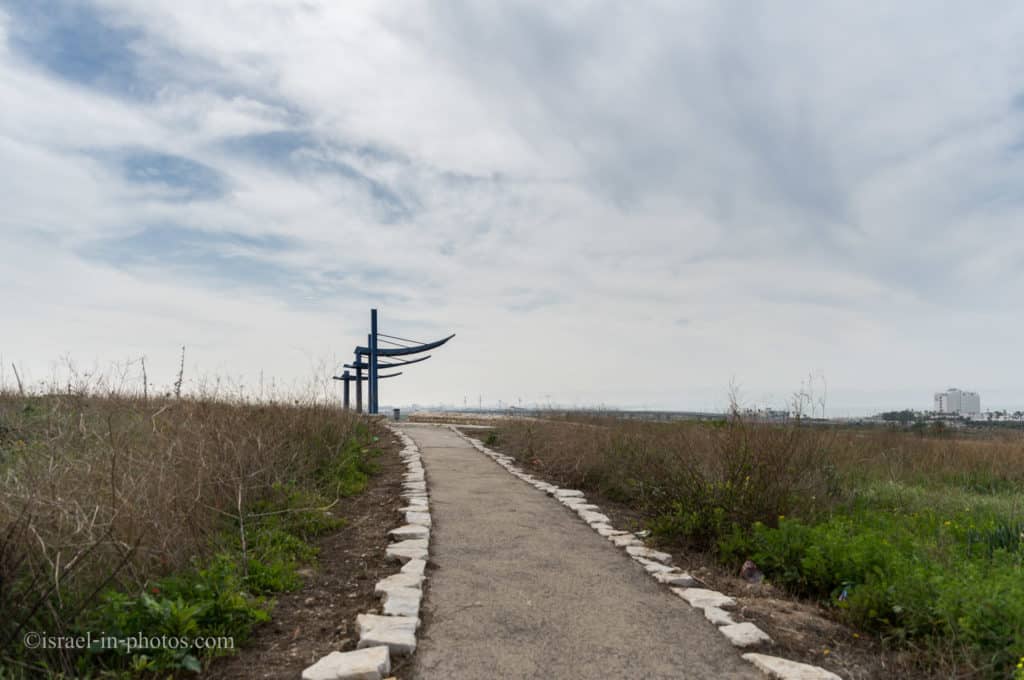
I was particularly interested in Tel Akko from a photography standpoint. Besides the regular walk, it was also a scouting mission. And this is what Old Acre looks like from Napoleon Hill.

I took that shot with a 70mm lens on a full-frame body. And as it turns out, the Tel is not a good viewpoint for photographers.
View to the East:

Napoleon at Acre
This Tel is also called Napoleon Hill, with a big statue installed at the top. It perpetuated Napoleon’s quest in 1799. During that quest, he tried to conquer Acre. And despite a long siege, the city has not fallen.
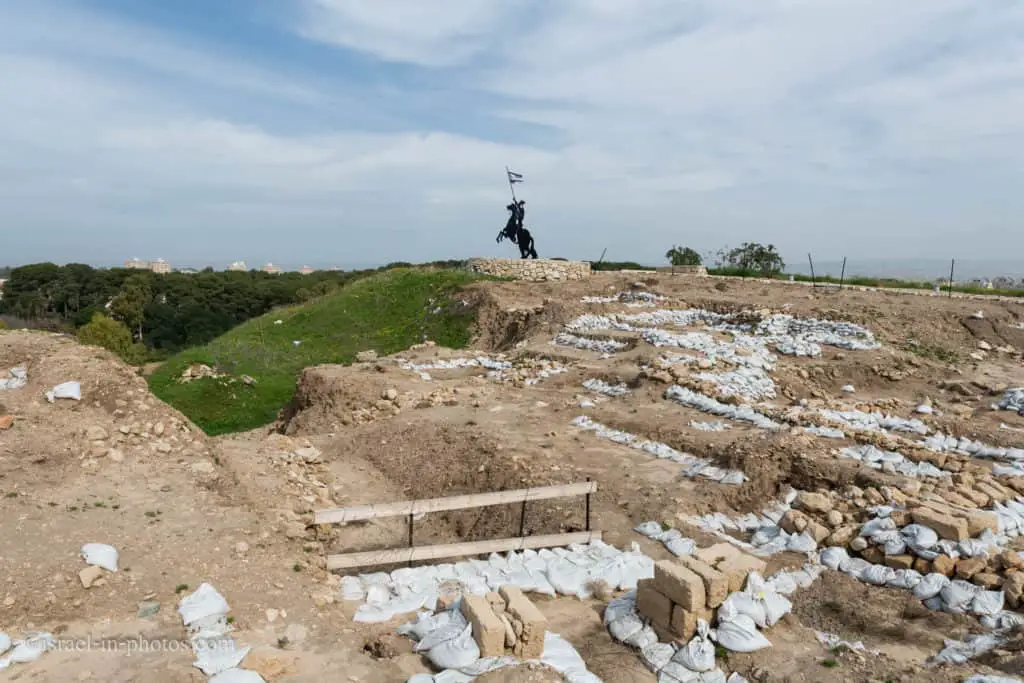
Near the statue, you can see an archeological site. That is a Tel. And you might think that the city of Acre was always in the same spot. But it started at this location. The town was at the same site until the Hellenistic period, when it moved closer to the sea to the west.
There are several routes around and near this Tel. We took the round path along the circumference of the top. The circular walk, with its several stops, took us about an hour.
Overall, the routes at the Tel are nice and short, but I would not consider them as top attractions in Acre.
Attractions Near Akko (Acre)
If you are thinking about making Acre your base, you can easily spend several nights there – one day exploring the city itself and another day exploring Haifa . Moreover, you can use the new sailing route I mentioned in Acre Port . Furthermore, you can spend one or several days exploring other attractions in this area. Here are several examples: Yehiam Fortress National Park and Rosh HaNikra grottoes . You can use the interactive map at the beginning of this post to find additional points of interest.
Walking Routes
In this guide, the attractions are divided by geographic location. Which is:
- Inside the Old City
- In the modern city of Akko and outside of the Old City
- Near the city
Note: all of the places are listed below.
The Old City is small (less than 1 square km), packed with attractions, and you can easily walk everywhere. Therefore many people visit only the Old City. Thus the following suggested walking routes refer only to sites in the Old City. On top of them (or instead of some of the mentioned sites), you can add additional attractions like Bahai Gardens in Akko .
What sites you should visit depends on various factors, like your interests and available time. I will answer this question using common interests, in other words, what most people do.
Suggested walking routes in the Old City according to available time:
- 2 – 3 hours : the Hospitaller Fortress . It will take most (if not all) of your time. And if you have some time, walk in the old city. Visit the alleys, Acre Port , and the market.
- 3 – 4 hours : in addition to the mentioned points of interest above, visit Al-Jazzar Mosque or The Templar Tunnel . You probably will not have enough time to visit both.
- 5 – 7 hours : this is probably the optimal duration. And it will allow you to visit the Hospitaller Fortress , Al-Jazzar Mosque , Templar Tunnel , walk in the old city, and even grab something to eat.
- Full day : to the places mentioned above, you can add the Turkish Bath and the lovely Treasures In The Walls Museum .
Where To Stay
The place of your stay depends on your route and where you decide to make your base. You can either stay at Acre (check prices and availability of both apartments and hotels on booking.com ). Or you can stay in Haifa (Haifa district on booking.com ) and reach the city by public transport. Another alternative would be staying somewhere in the area and reaching Akko by car for a visit (North district on booking.com ).
Common Questions
Akko is an ancient port city in northern Israel. It is one of the oldest cities in the world, continuously inhabited since the Middle Bronze Age. And today, it is a popular travel destination.
Akko is mentioned in Egyptian writings from the 15th century BCE. But archeological findings at Tel Akko show a small settlement existed in the Early Bronze Age (around 3000 BCE).
After the Crusaders’ conquest, the city was renamed Saint John of Acre (or shortly Acre), after the Knights Hospitaller, who had their headquarters there.
The Old City of Acre, a UNESCO World Heritage site, is famous for its medieval Crusader buildings under and above the ground. Moreover, Acre is an important example of an Ottoman-walled town. It has typical urban elements such as the citadel, mosques, khans, and baths.
If you love history and archeology, then Akko is worth a visit. Akko is one of the oldest cities in the world, with a rich history. Most historical structures belong to medieval Crusaders or 18 – 19 century Muslims.
Akko is perfectly safe. I visited the city alone and with my family more than a dozen times and never felt threatened. But of course, you should use common sense.
Akko (Acre) offers many attractions, and you can easily spend the whole day there. Moreover, remember that I did not cover all the tourist attractions. But, we did over the main ones, which is more than most people visit.
Hence, after reading this post, you might ask which of the mentioned attractions above you should visit. Check out the suggested walking routes above. Moreover, you can see points of interest near the city.
What is your favorite place in Akko? Tell us in the comments below.
That’s all for today, and I’ll see you in future travels!
Stay Tuned!
For additional attractions nearby, see Haifa .
Additional Resources
- Israel Trip Planner is the page that will help you to create your perfect travel route.
- National Parks And Nature Reserves page lists and put all national parks on the map. There is also a top list, information about ticket types and campsites.
- If you are looking for things to do, here are the pages for Jerusalem , Tel Aviv , Haifa , Sea Of Galilee , and Makhtesh Ramon .
- Wondering what events are there in Israel? Here is the Events And Festivals By Season guide.
Lev Tsimbler
Lev from israel-in-photos.com. You can contact me at [email protected]
Leave a Reply Cancel reply
Your email address will not be published. Required fields are marked *
Save my name and email in this browser for the next time I comment.
Recent Posts
Wadi Bokek - Water Trail by the Dead Sea - Visitors Guide
Wadi Bokek offers a short water trail by the Dead Sea. This easy hike offers water, greenery, and waterfalls. Perfect for hot days. Map Wadi Bokek is located near the Hotel's area at Ein...
Dead Sea Mushrooms - Visitors Guide
Dead Sea Mushrooms is a nature wonder. They are located south of Public Beach #6 by Isrotel Hotel and close to the Dome Dead Sea (expo center). Map Dead Sea Mushrooms are located by the Dome...

Recognized by UNESCO as a World Heritage Site, visiting Acre (Akko) promises visitors an emotional journey to a glorious past and a one-of-a-kind experience. An ancient and wondrous city, Akko boasts many remarkable sites including the remnants of the Hellenistic-Roman period as well as structures from the Crusader and Ottoman periods.
Much more than a historical and archeological marvel, Akko also has colorful Oriental markets, museums, beaches and water sports facilities, a fishermen’s port, marina, restaurants, hotels, and annual picturesque festivals – all that and more are just a few of the city’s fantastic tourist attractions.
The city's fascinating historical heritage, its rare blend of East and West, authentic glimpses from the past and unique remnants from different cultures, have all made Akko into one of the most vital Ancient World cities.

The Knights' Halls
A magnificent tour of the halls of the Hospitallers Order’s Fortress from the Crusader period. Discover the amazing remains of the ancient Order, the renovated and stunningly reconstructed halls, courtyard and surrounding streets, and step into history as a 830-year old story unfolds before you within the halls of the citadel.
Be sure to visit the streets, chapels, stores and the Arts and Crafts Market, featuring artisans from the Crusades era, offering their wares: blacksmiths, glass blowers, potters, weavers, embroiderers, leather craftsmen, basket weavers, perfume and oil craftsmen, and more

Things to Do in Monino, Russia - Monino Attractions
Things to do in monino.
- 5.0 of 5 bubbles
- Good for Kids
- Budget-friendly
- Hidden Gems
- Good for Big Groups
- Adventurous
- Good for a Rainy Day
- Good for Couples
- Honeymoon spot
- Good for Adrenaline Seekers
- Things to do ranked using Tripadvisor data including reviews, ratings, photos, and popularity.

1. The Central Air Force Museum
2. Church of St. George
- Election 2024
- Entertainment
- Newsletters
- Photography
- Personal Finance
- AP Investigations
- AP Buyline Personal Finance
- AP Buyline Shopping
- Press Releases
- Israel-Hamas War
- Russia-Ukraine War
- Global elections
- Asia Pacific
- Latin America
- Middle East
- Election Results
- Delegate Tracker
- AP & Elections
- Auto Racing
- 2024 Paris Olympic Games
- Movie reviews
- Book reviews
- Personal finance
- Financial Markets
- Business Highlights
- Financial wellness
- Artificial Intelligence
- Social Media
The Unique Burial of a Child of Early Scythian Time at the Cemetery of Saryg-Bulun (Tuva)
<< Previous page
Pages: 379-406
In 1988, the Tuvan Archaeological Expedition (led by M. E. Kilunovskaya and V. A. Semenov) discovered a unique burial of the early Iron Age at Saryg-Bulun in Central Tuva. There are two burial mounds of the Aldy-Bel culture dated by 7th century BC. Within the barrows, which adjoined one another, forming a figure-of-eight, there were discovered 7 burials, from which a representative collection of artifacts was recovered. Burial 5 was the most unique, it was found in a coffin made of a larch trunk, with a tightly closed lid. Due to the preservative properties of larch and lack of air access, the coffin contained a well-preserved mummy of a child with an accompanying set of grave goods. The interred individual retained the skin on his face and had a leather headdress painted with red pigment and a coat, sewn from jerboa fur. The coat was belted with a leather belt with bronze ornaments and buckles. Besides that, a leather quiver with arrows with the shafts decorated with painted ornaments, fully preserved battle pick and a bow were buried in the coffin. Unexpectedly, the full-genomic analysis, showed that the individual was female. This fact opens a new aspect in the study of the social history of the Scythian society and perhaps brings us back to the myth of the Amazons, discussed by Herodotus. Of course, this discovery is unique in its preservation for the Scythian culture of Tuva and requires careful study and conservation.
Keywords: Tuva, Early Iron Age, early Scythian period, Aldy-Bel culture, barrow, burial in the coffin, mummy, full genome sequencing, aDNA
Information about authors: Marina Kilunovskaya (Saint Petersburg, Russian Federation). Candidate of Historical Sciences. Institute for the History of Material Culture of the Russian Academy of Sciences. Dvortsovaya Emb., 18, Saint Petersburg, 191186, Russian Federation E-mail: [email protected] Vladimir Semenov (Saint Petersburg, Russian Federation). Candidate of Historical Sciences. Institute for the History of Material Culture of the Russian Academy of Sciences. Dvortsovaya Emb., 18, Saint Petersburg, 191186, Russian Federation E-mail: [email protected] Varvara Busova (Moscow, Russian Federation). (Saint Petersburg, Russian Federation). Institute for the History of Material Culture of the Russian Academy of Sciences. Dvortsovaya Emb., 18, Saint Petersburg, 191186, Russian Federation E-mail: [email protected] Kharis Mustafin (Moscow, Russian Federation). Candidate of Technical Sciences. Moscow Institute of Physics and Technology. Institutsky Lane, 9, Dolgoprudny, 141701, Moscow Oblast, Russian Federation E-mail: [email protected] Irina Alborova (Moscow, Russian Federation). Candidate of Biological Sciences. Moscow Institute of Physics and Technology. Institutsky Lane, 9, Dolgoprudny, 141701, Moscow Oblast, Russian Federation E-mail: [email protected] Alina Matzvai (Moscow, Russian Federation). Moscow Institute of Physics and Technology. Institutsky Lane, 9, Dolgoprudny, 141701, Moscow Oblast, Russian Federation E-mail: [email protected]
Shopping Cart Items: 0 Cart Total: 0,00 € place your order
Price pdf version
student - 2,75 € individual - 3,00 € institutional - 7,00 €

Copyright В© 1999-2022. Stratum Publishing House
- Yekaterinburg
- Novosibirsk
- Vladivostok

- Tours to Russia
- Practicalities
- Russia in Lists
Rusmania • Deep into Russia
Out of the Centre
Savvino-storozhevsky monastery and museum.

Zvenigorod's most famous sight is the Savvino-Storozhevsky Monastery, which was founded in 1398 by the monk Savva from the Troitse-Sergieva Lavra, at the invitation and with the support of Prince Yury Dmitrievich of Zvenigorod. Savva was later canonised as St Sabbas (Savva) of Storozhev. The monastery late flourished under the reign of Tsar Alexis, who chose the monastery as his family church and often went on pilgrimage there and made lots of donations to it. Most of the monastery’s buildings date from this time. The monastery is heavily fortified with thick walls and six towers, the most impressive of which is the Krasny Tower which also serves as the eastern entrance. The monastery was closed in 1918 and only reopened in 1995. In 1998 Patriarch Alexius II took part in a service to return the relics of St Sabbas to the monastery. Today the monastery has the status of a stauropegic monastery, which is second in status to a lavra. In addition to being a working monastery, it also holds the Zvenigorod Historical, Architectural and Art Museum.
Belfry and Neighbouring Churches

Located near the main entrance is the monastery's belfry which is perhaps the calling card of the monastery due to its uniqueness. It was built in the 1650s and the St Sergius of Radonezh’s Church was opened on the middle tier in the mid-17th century, although it was originally dedicated to the Trinity. The belfry's 35-tonne Great Bladgovestny Bell fell in 1941 and was only restored and returned in 2003. Attached to the belfry is a large refectory and the Transfiguration Church, both of which were built on the orders of Tsar Alexis in the 1650s.

To the left of the belfry is another, smaller, refectory which is attached to the Trinity Gate-Church, which was also constructed in the 1650s on the orders of Tsar Alexis who made it his own family church. The church is elaborately decorated with colourful trims and underneath the archway is a beautiful 19th century fresco.
Nativity of Virgin Mary Cathedral

The Nativity of Virgin Mary Cathedral is the oldest building in the monastery and among the oldest buildings in the Moscow Region. It was built between 1404 and 1405 during the lifetime of St Sabbas and using the funds of Prince Yury of Zvenigorod. The white-stone cathedral is a standard four-pillar design with a single golden dome. After the death of St Sabbas he was interred in the cathedral and a new altar dedicated to him was added.

Under the reign of Tsar Alexis the cathedral was decorated with frescoes by Stepan Ryazanets, some of which remain today. Tsar Alexis also presented the cathedral with a five-tier iconostasis, the top row of icons have been preserved.
Tsaritsa's Chambers

The Nativity of Virgin Mary Cathedral is located between the Tsaritsa's Chambers of the left and the Palace of Tsar Alexis on the right. The Tsaritsa's Chambers were built in the mid-17th century for the wife of Tsar Alexey - Tsaritsa Maria Ilinichna Miloskavskaya. The design of the building is influenced by the ancient Russian architectural style. Is prettier than the Tsar's chambers opposite, being red in colour with elaborately decorated window frames and entrance.

At present the Tsaritsa's Chambers houses the Zvenigorod Historical, Architectural and Art Museum. Among its displays is an accurate recreation of the interior of a noble lady's chambers including furniture, decorations and a decorated tiled oven, and an exhibition on the history of Zvenigorod and the monastery.
Palace of Tsar Alexis

The Palace of Tsar Alexis was built in the 1650s and is now one of the best surviving examples of non-religious architecture of that era. It was built especially for Tsar Alexis who often visited the monastery on religious pilgrimages. Its most striking feature is its pretty row of nine chimney spouts which resemble towers.

Plan your next trip to Russia
Ready-to-book tours.
Your holiday in Russia starts here. Choose and book your tour to Russia.
REQUEST A CUSTOMISED TRIP
Looking for something unique? Create the trip of your dreams with the help of our experts.

COMMENTS
See ways to experience (3) 7. Valuta. 5. Art Galleries. A unique jewelry shop located in the Turkish Bazaar in the old city of Acre. Among the jewelry you will find elements such as old Israeli coins, old coins from around the world, diamonds, natural gemstones, freshwater pearls, Roman glass and more.
Recognized by UNESCO as a World Heritage Site, visiting Acre (Akko) promises visitors an emotional journey to a glorious past and a one-of-a-kind experience. ... All Year Low Season Rate deal for tours to Israel. book now. Trips Israel LLC. $1,295. Christian Holy Land Tours from $1,295. book now. Panorma Travel. $1,299. Discover Jerusalem ...
Akko (Acre) Akko (Acre) represents the tumultuous history of the Land of Israel possibly better than any other city in the country. Akko is a city that has been shaped by the Romans, Ottomans, Crusaders, Mamelukes, Byzantines, and British. Today it is home to a brilliantly coexistent mixed population of Jews, Christians and Muslims.
Akko (Acre) is one of Israel's top attractions due to its history, architecture, and coastal location. In this Akko travel guide, we share tips on the best things to see and do while there, where to stay, how to get, what to wear, when to go, or whether it is worth a visit.
Khan Al Umdan. The oldest caravanserai (a huge inn where travelers could rest) in Israel, this was first built in 1784 during the rule of Ahmad Jazzar Pasha, when Acre was part of the Ottoman Empire. At the time, it was one of four caravanserai in Acre, but this one was known as Khan Al Umdan or "Inn of the Columns.".
Port of Acre, Northern Israel. The port city of Akko (also known as Acre) is one of the oldest continuously inhabited sites in the world. Owing to its natural harbor on the Mediterranean sea, it served as a strategic link to the Levant. The ancient Akko, first mentioned in the Egyptian Execration Texts almost 4,000 years ago, lies to the east ...
Acre (sometimes also referred to as Akko) is one of the main attractions in northern Israel, located only 25 km north of Haifa and more than 100 km from Tel Aviv.Despite being much smaller than Haifa, Akko is clearly the better tourist destination.
Akko/Acre Recognized by UNESCO as a World Heritage Site, visiting Acre (Akko) promises visitors an emotional journey to a glorious past and a one-of-a-kind experience. ... All Year Low Season Rate deal for tours to Israel. book now. Trips Israel LLC. $1,295. Christian Holy Land Tours from $1,295. book now. Panorma Travel. $1,299. Discover ...
Home - OLD AKKO. Don't miss our special All Inclusive ticket at a special price: 49 NIS per person! For accessibility info regarding your visit, contact us on WhatsApp or call us: 972-4-9956706/7. Dear Visitors As of November 1, 2022, the sites' visiting hours are changed to winter time, for more information check our tourist info or call: 04 ...
It's not exactly on the main tourist trail, but there are plenty of awesome things to check out; definite must-sees in Acre include the Old City, with its shabby glamor and funky open-air market, the Hospitaller Fortress where you feel like you're walking in a time warp C.E. 1230, and the marina, with its fishing port and lighthouse.
Things to Do in Acre, Israel: See Tripadvisor's 13,880 traveller reviews and photos of Acre tourist attractions. Find what to do today, this weekend, or in May. ... Acre Tourism Acre Hotels Bed and Breakfast Acre Acre Holiday Rentals Flights to Acre Acre Restaurants Acre Attractions Acre Travel Forum Acre Photos Acre Map.
Akko in Israel, called Acre in the Bible: Exotic, Authentic, Unforgettable. Akko, the place called Acre in the Bible, is one of the most thrilling spots in Israel. It's like nowhere else, with spectacular sights, stirring history, and an intensely exotic aura. However you refer to it, (Akko, Acco, or Acre), being inside this Biblical port city ...
4. Breath in the sea air on the city walls. Akko was a historic port city of strategic importance. During the 18th and 19th century, its Ottoman rulers fortified the city with a strong stone wall built around it. Today you can walk along the wall for amazing views of the Mediterranean.
Israel Travel Guide. 14 Top-Rated Tourist Attractions in Israel and the Palestinian Territories. 20 Top-Rated Things to Do in Jerusalem. ... were unable to take the town until 1104, five years after their conquest of Jerusalem. They renamed it St. Jean d'Acre, and it became the headquarters of the Knights of St. John. The Italian cities of ...
Basic Info. Acre is a historic city in Northern Israel. It is located on the edge of Haifa Bay (on the coast of the Mediterranean Sea). Both land routes and sea paths (Acre has a natural harbor) made Acre a commercial standpoint. And it is one of the oldest cities in the world, continuously inhabited since the Middle Bronze Age (around 4,000 ...
Recognized by UNESCO as a World Heritage Site, visiting Acre (Akko) promises visitors an emotional journey to a glorious past and a one-of-a-kind experience. An ancient and wondrous city, Akko boasts many remarkable sites including the remnants of the Hellenistic-Roman period as well as structures from the Crusader and Ottoman periods.
Opening hours: Winter: Sun-Thu, Sat 08:30-17:30, Fri 08:30-16:30. Summer: Sun-Thu, Sat 09:30-18:30, Fri 09:30-17:30. Our Private Haifa, Caesarea, Akko and Rosh Hanikra Tour is the best way to see the highlights of Israel's beautiful and historic northern coast. The tour can be personalized to fit all of your desires and travel needs.
The city of Acre (Akko) is one of the most ancient port cities in the Middle East. Located in northern Israel on the western Mediterranean coast, Acre is recognized as a world heritage site by UNESCO. The city contains some of the oldest archaeological ruins in Israel and beneath the ground is a whole other universe of tunnels, remnants from the Crusader Period.
Things to Do in Monino, Russia: See Tripadvisor's 294 traveler reviews and photos of Monino tourist attractions. Find what to do today, this weekend, or in September. We have reviews of the best places to see in Monino. Visit top-rated & must-see attractions.
Drone imaging of the forest is being analysed by AI - with less than 2% of the 10,000 acre area having been covered so far. Image source, University of Southampton Image caption,
Israel-Hamas war. Texas power outage. Pope Francis apology. Ángel Hernández retires. ... Vulcan Materials valued the almost 6,000-acre (2,400 hectare) property, located just south of the resort town of Playa del Carmen, at $1.9 billion. ... The Mayan Train is a pet project of López Obrador to build a tourist train around the Yucatan peninsula.
Elektrostal. Elektrostal ( Russian: Электроста́ль) is a city in Moscow Oblast, Russia. It is 58 kilometers (36 mi) east of Moscow. As of 2010, 155,196 people lived there.
A Michigan mother died after pushing her 2-year-old daughter away from an out-of-control vehicle at a drag racing event on Sunday, police say. Kadie Price, 33, was a spectator at the racing event ...
Burial 5 was the most unique, it was found in a coffin made of a larch trunk, with a tightly closed lid. Due to the preservative properties of larch and lack of air access, the coffin contained a well-preserved mummy of a child with an accompanying set of grave goods. The interred individual retained the skin on his face and had a leather ...
Zvenigorod's most famous sight is the Savvino-Storozhevsky Monastery, which was founded in 1398 by the monk Savva from the Troitse-Sergieva Lavra, at the invitation and with the support of Prince Yury Dmitrievich of Zvenigorod. Savva was later canonised as St Sabbas (Savva) of Storozhev. The monastery late flourished under the reign of Tsar ...